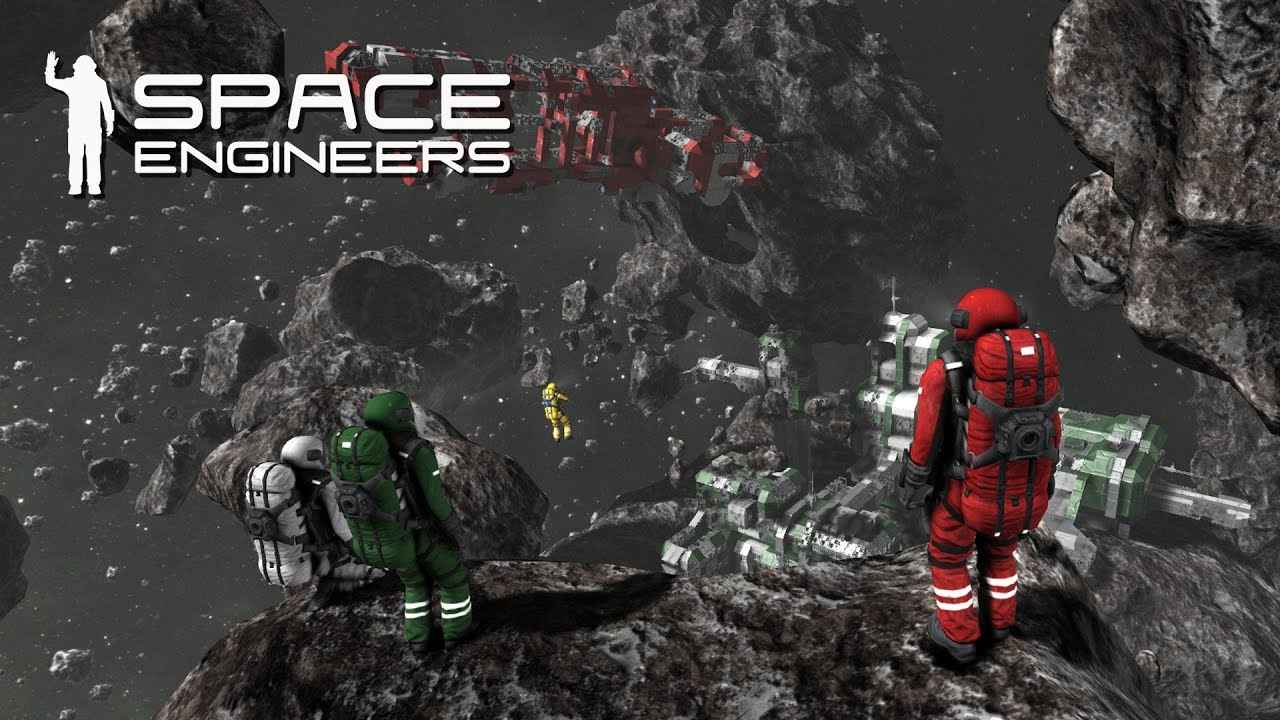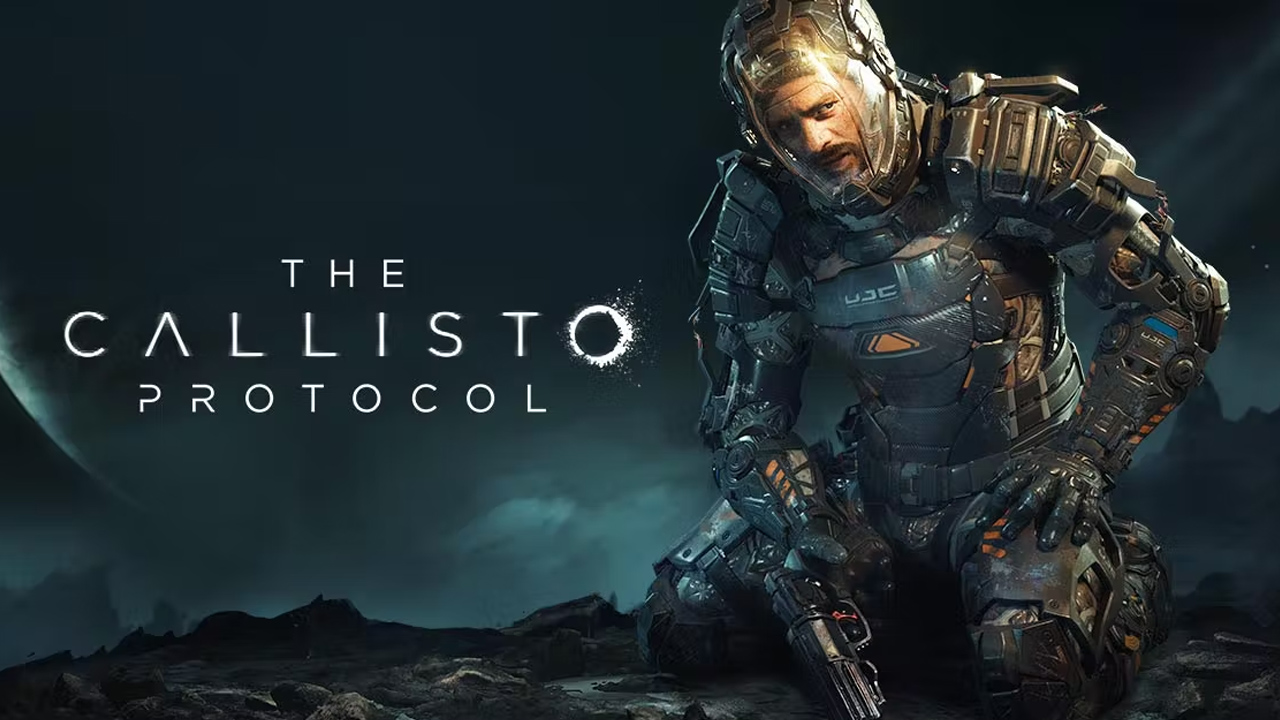Universal solution for quick survival on any vanilla planets and moons including Europa, Moon and Pertam.
Game start
Quick survival is such an organization of the gameplay that, under any starting conditions, requires a minimum time for the development of your ship and base by minimizing movement around the world, automating stone extraction and optimizing the production process of components.
To start a new survival game, you need to select the “Star System” scenario and set the basic world settings. I recommend maximum values for all parameters – from inventory size, to assembly and welding speed. This does not affect the process itself in any way, but it will reduce the waiting time for processes to terminate.
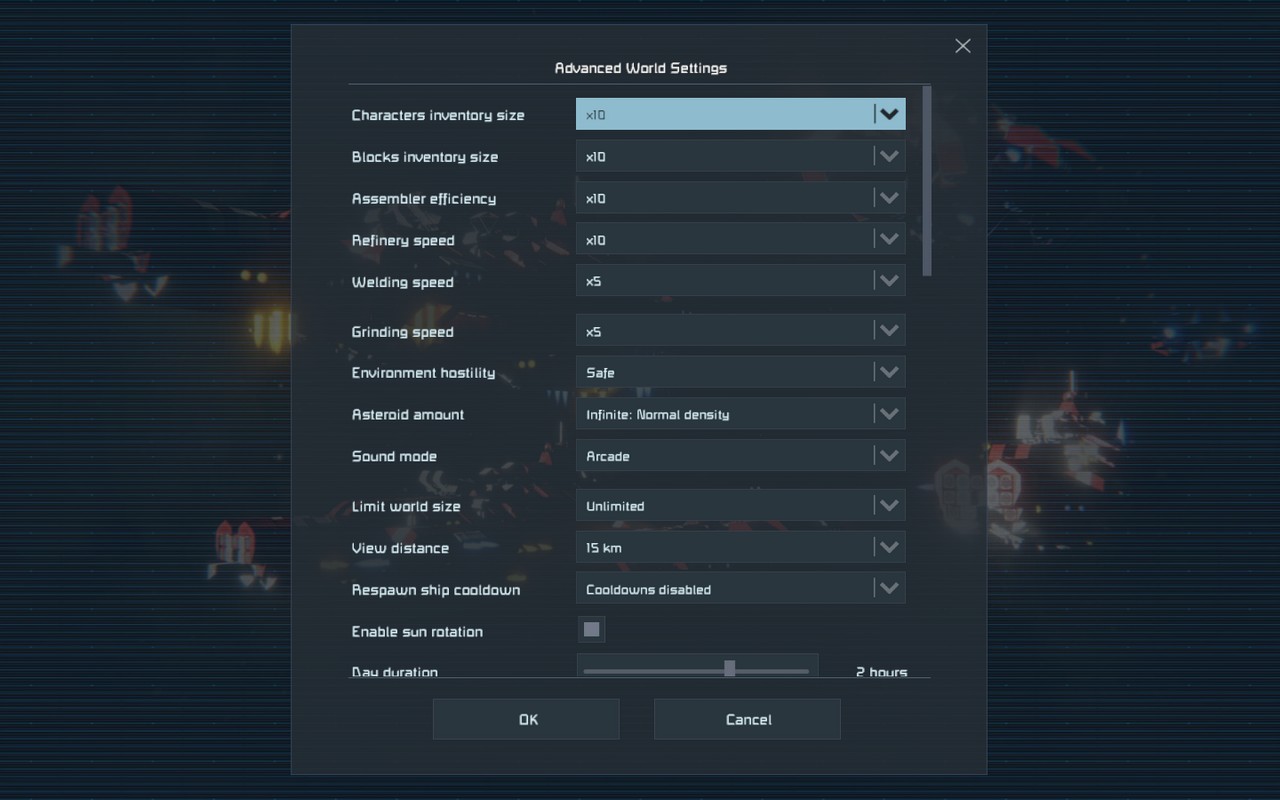
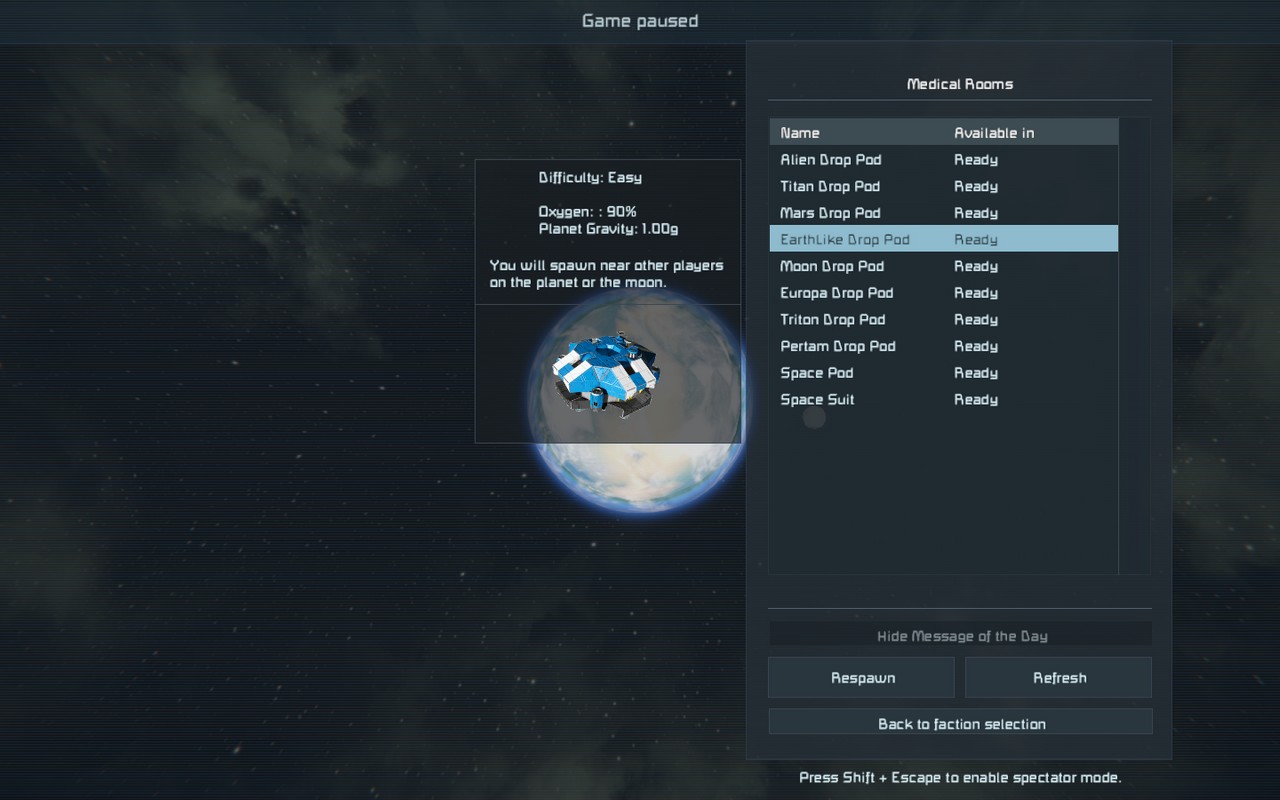
At the start of survival on most planets and moons, you will be given a Respawn Pod (capsule) that will take you to the surface by parachute. You will need stone, from which you can produce components for your base and ship in the Survial Kit, and ice, with which you can fly away from the planet on hydrogen boosters and explore the entire star system. Therefore, at the first stage, survival will be reduced to finding these things.
After respawning in the new world and landing the landing of the capsule follows:
1. Turn off the O2/H2 generator
2. Pick up the weapon from the chair
If there is no source of ice or stone near the landing site, then it is advisable to find it. For this:
1. Move 150 m away from the capsule and climb vertically on the jetpack and look around
2. If you see what you need, go down and set the GPS mark in the direction in which you need to fly
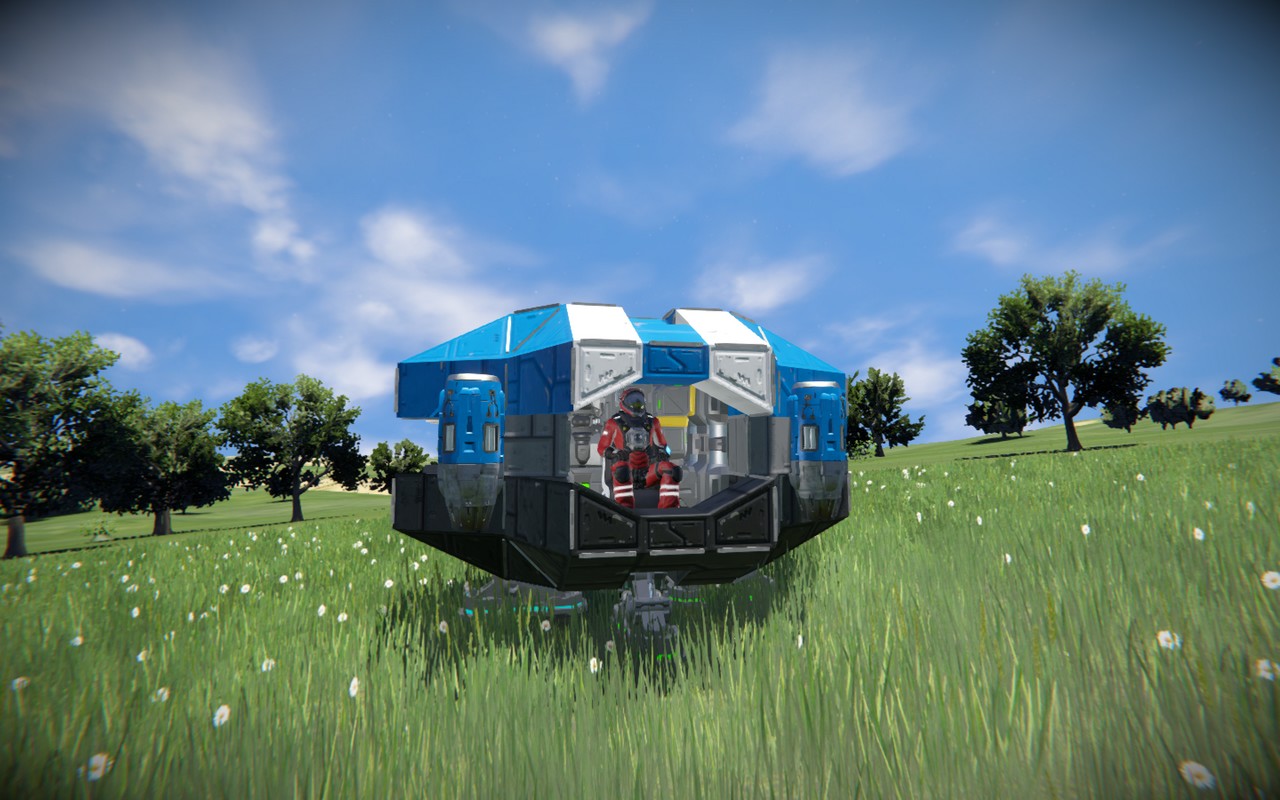
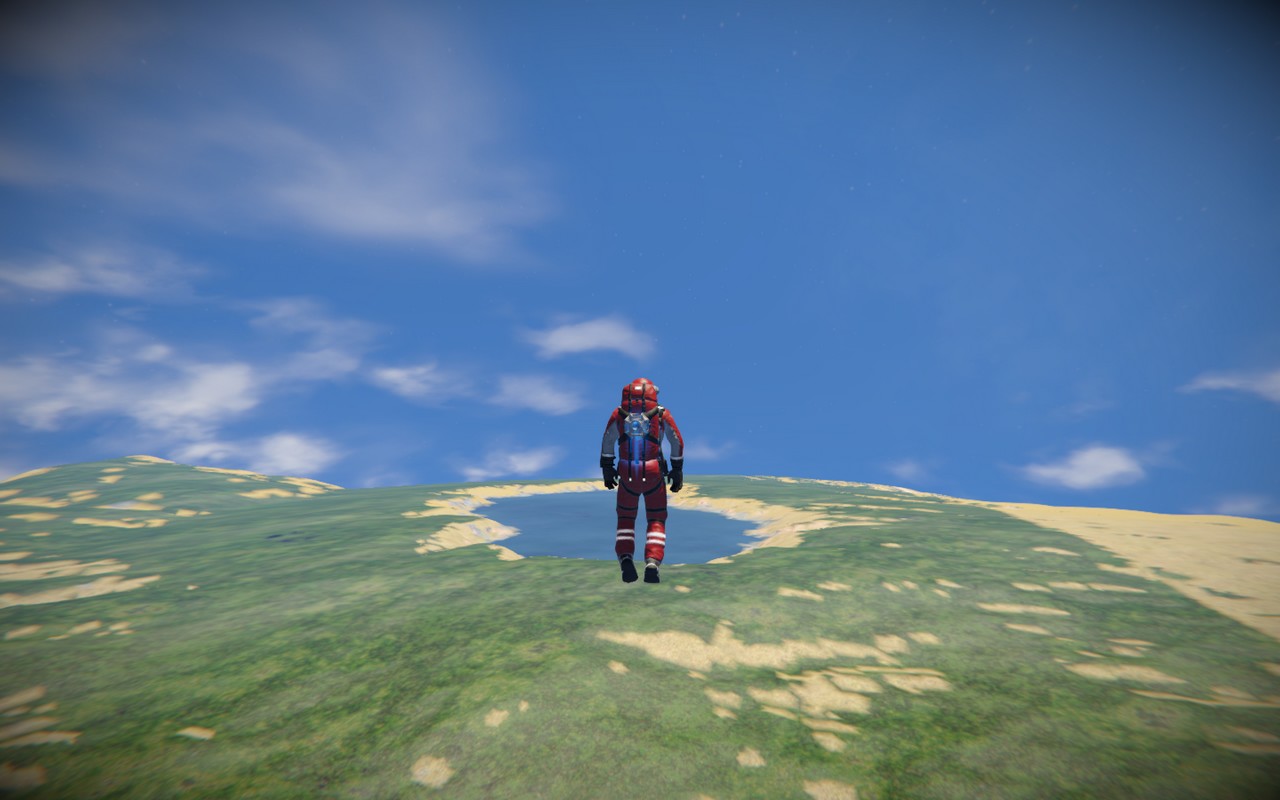
If ice is not found, then it can be found after you build an atmospheric miner that can fly long distances. When surviving on Pertham, this is probably what you should do, since ice is rare there.
There is also the opposite situation, when there is a lot of ice around, but there is no stone nearby. You will most likely encounter it if you start survival on Triton. Here you will have to find a rocky outcrop of stone and fly over to it. In total, you will need to manually mine 1 ton of stone in order to continue the game, although there is an option when you do not have to dig with a hand drill at all, you can read about this in the “Survival on Europe” section.
Progress and Stone
Before opening the progress tree, dig up 1 ton of stone with a hand drill and order the production of 200 gravel, 14 computers and 4 screens in the Survial Kit. Then:
1. incise and weld back any chassis, then saw off the front and rear chassis
2. cut the chair and part of the armor blocks from the nose so that the grinder can reach the blocks behind it
3. incise and weld back the small container and any conveyor, add two armor blocks to the bottom
4. cut down all blocks adjacent to the Survial Kit and the hydrogen thruster
5. install two small conveyors so that they can connect the generator to the cockpit
6. incise the generator so that the large still tubes are in your inventory
7. build a cockpit at the place where the chair was, docking it with the conveyors (no glass needed)
8. cut off the antenna and put a gyroscope in its place (the capsule has its own permanent mark)
9. cut the thrusters and set them up in the directions left / right / back
10. weld the drill in front of the cockpit and turn it on
11. remove car parking from chassis
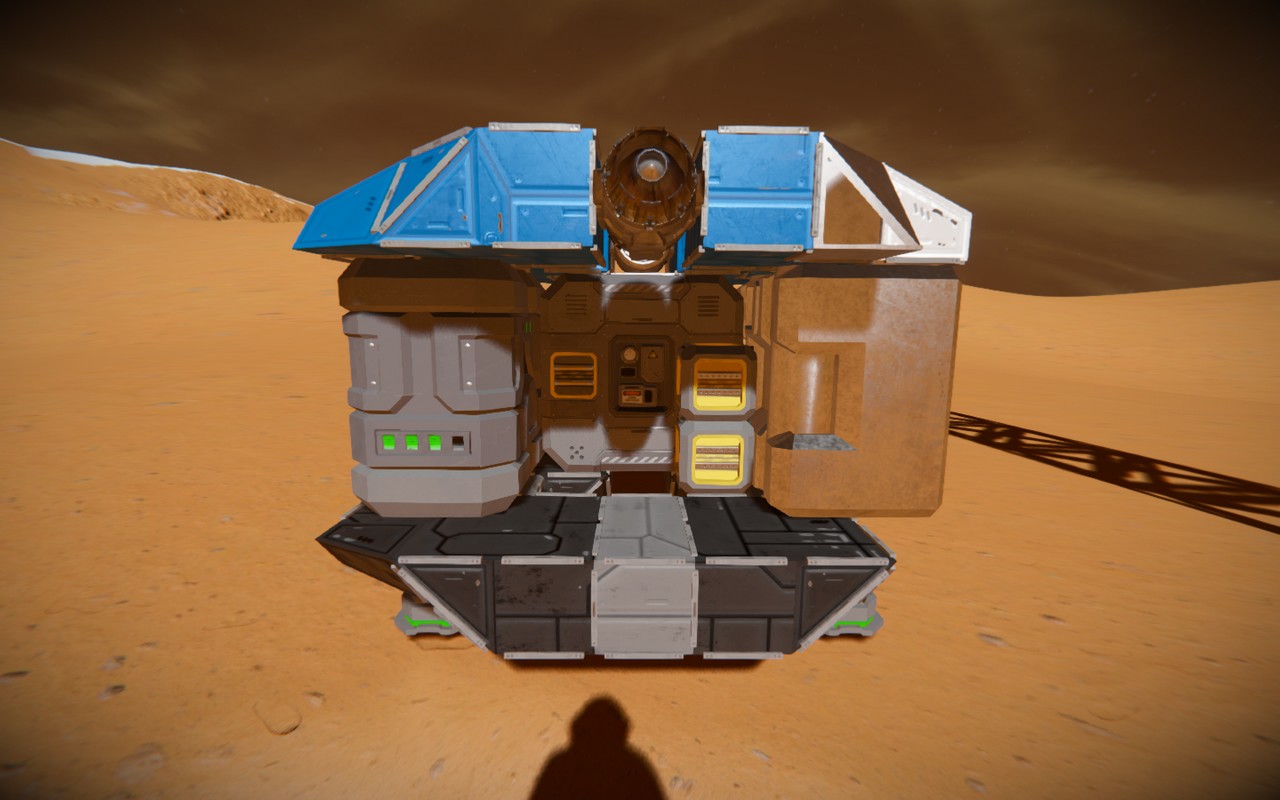
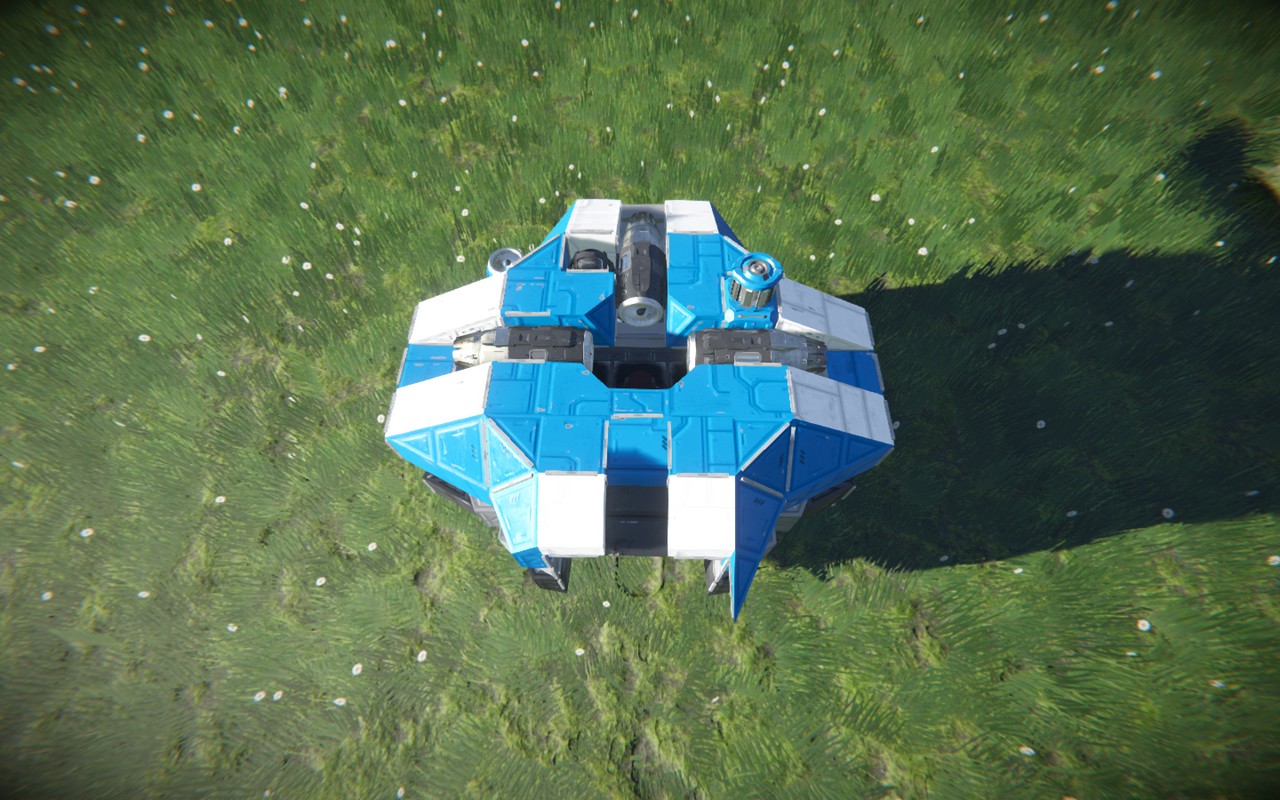
Gently lower the drill forward for 3-4 seconds and return to a horizontal position using the gyroscope. Turn the ship with a gyroscope from side to side until you have dug up 20 tons of stone.
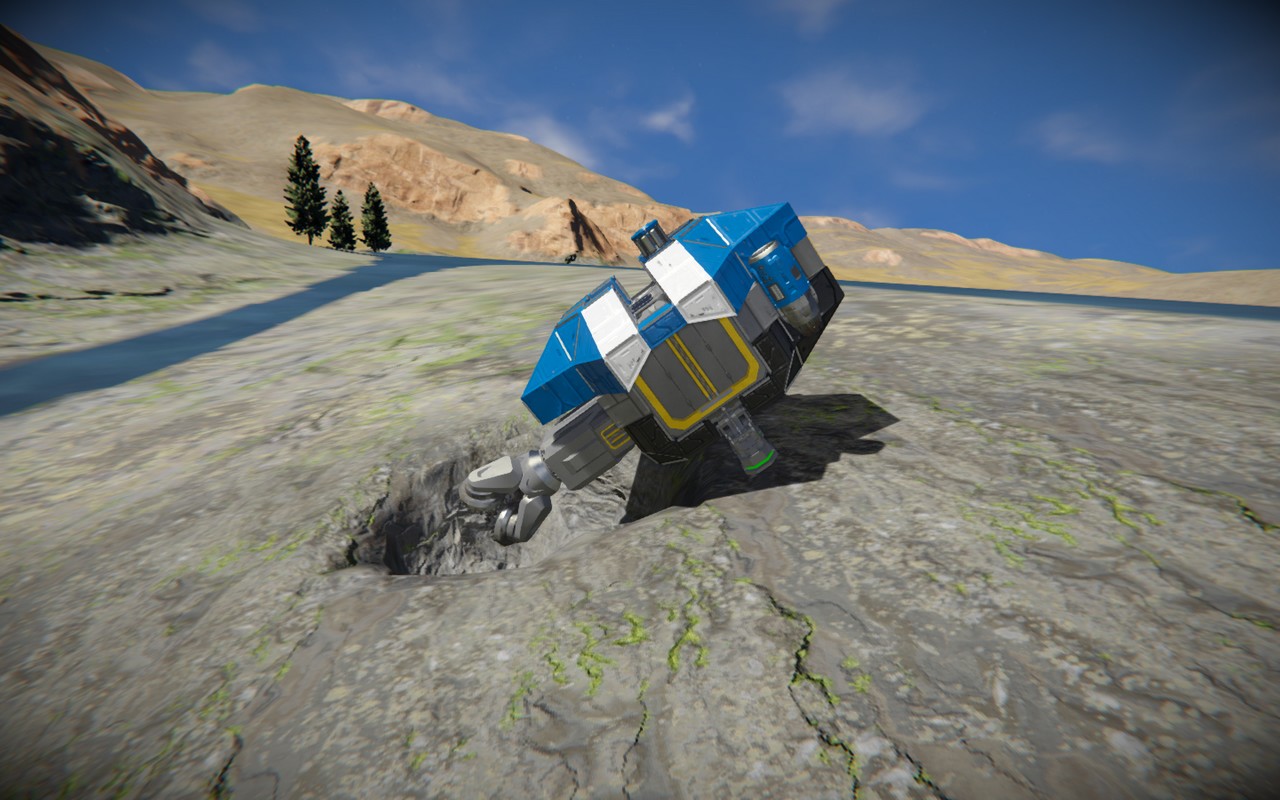
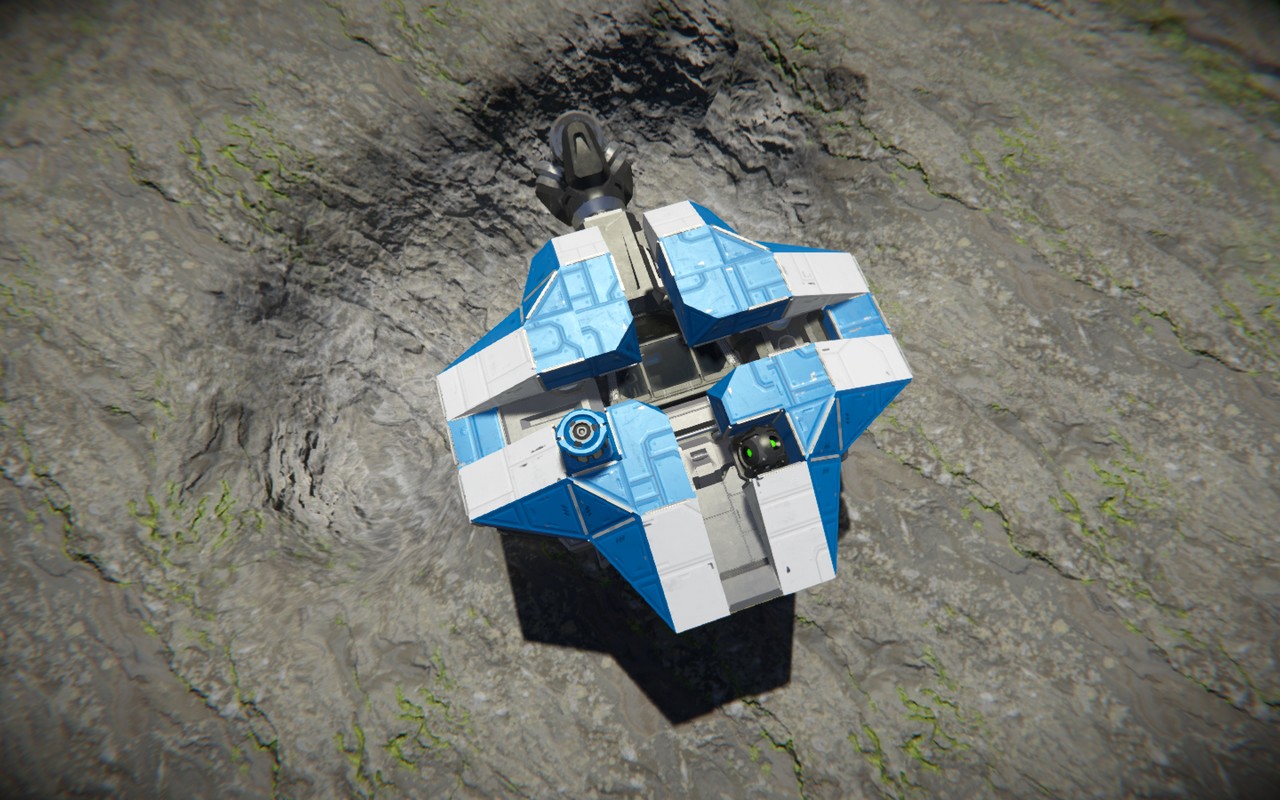
If the capsule landed on ice or snow, then follow through to step 8, and then:
- cut down 3 atmospheric thrusters and set them up in the left/right/forward directions
- turn off all thrusters and group them for easy control
- unpark landing gear and use the gyroscope to tilt the capsule back
Turn on all thrusters and carefully rise above the surface of the planet using the “forward” key. Fly at low speed at an angle of 25-30 degrees to gravity towards the nearest rocky surface and land the capsule on it. Then return to the previous algorithm.
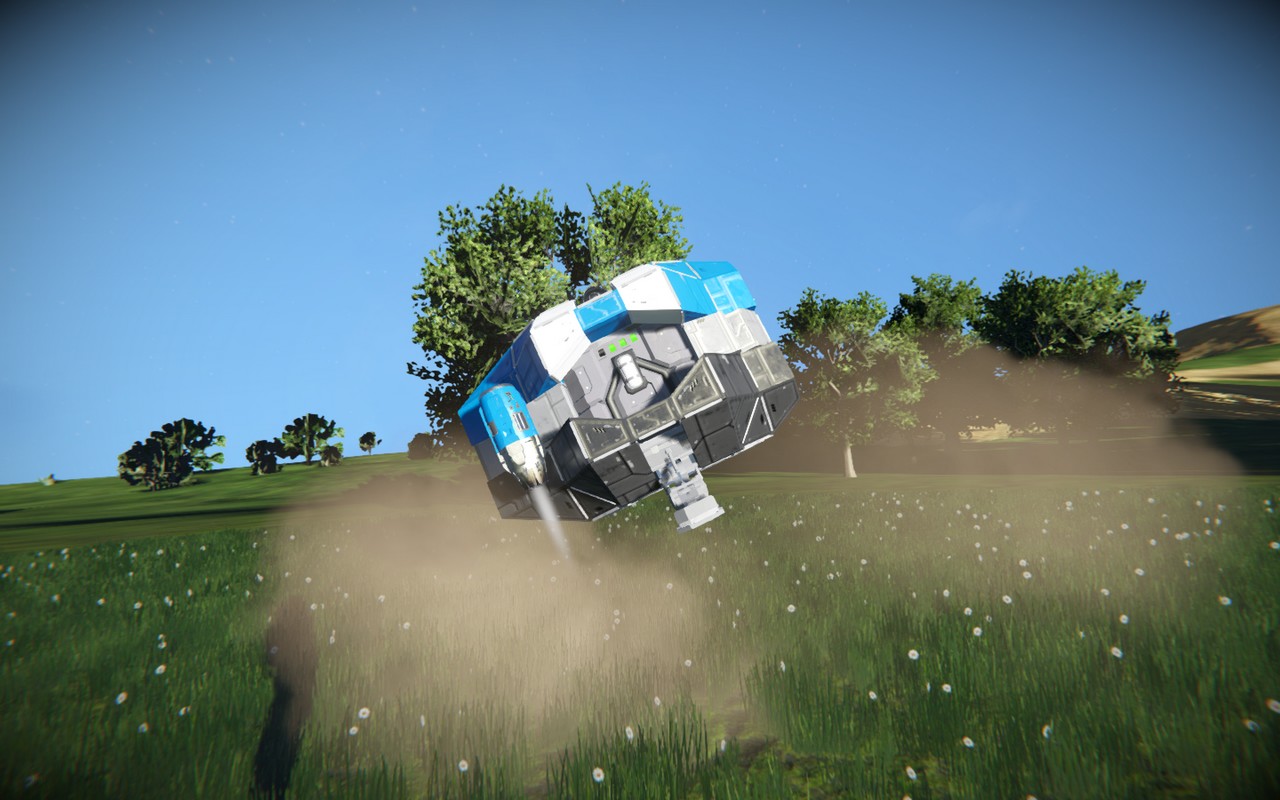
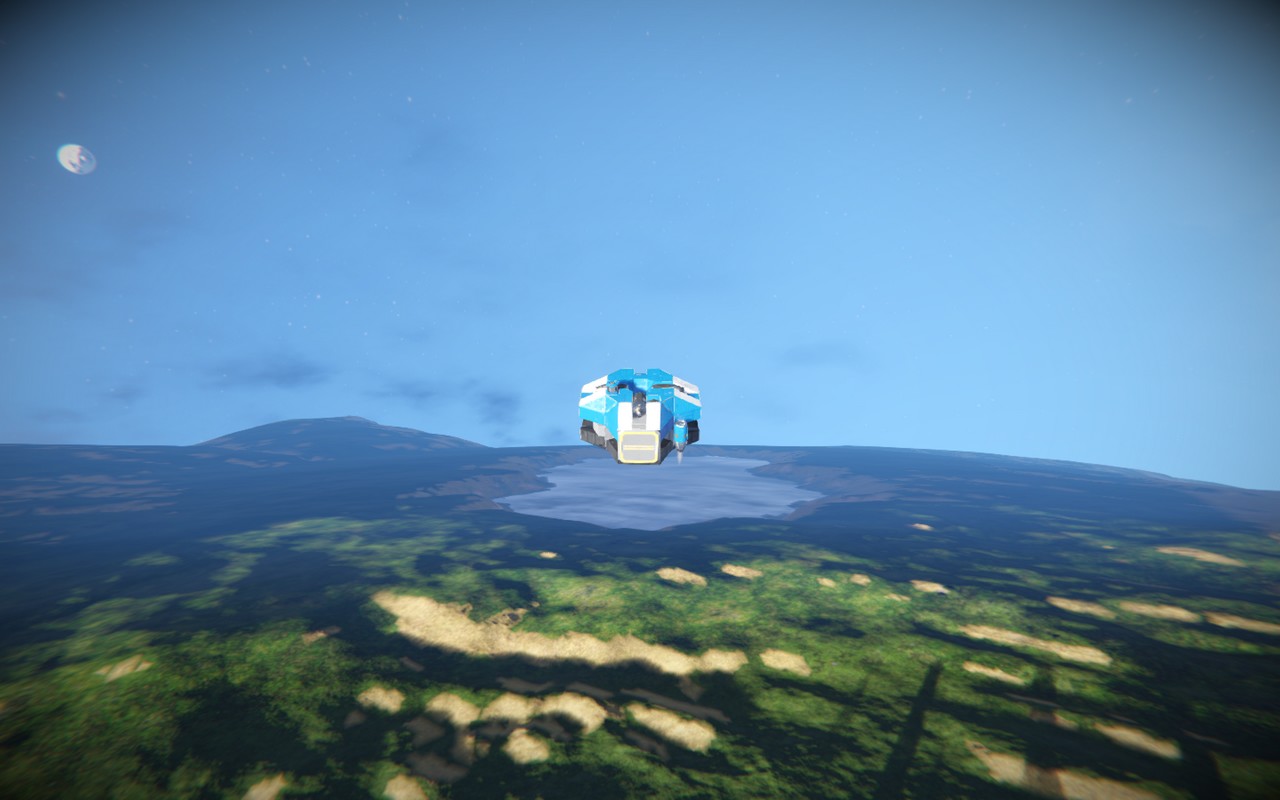
Large Tubes and Miner
To build a full-fledged ship with atmospheric thrusters on all axes, you need large steel tubes. To produce them, you need to power the base assembler from the wind generator, transfer the ingots from the Survival Module to it and order 10 tubes. For what:
1. install 5 unwelded blocks of large armor on the surface and install a wind generator on them
2. at the bottom, install the base assembler steel plates for which you can take from the capsule casing
3. transfer the rest of the ingots from the survival module to the faucet order the production of 10 tubes
It remains to add the missing atmospheric thrusters to the capsule, one for all axes, and two for lifting. You can order components for thrusters from the assembler in the process. After that, it remains to saw the turbine and the assembler and you can fly to choose a place for the base.
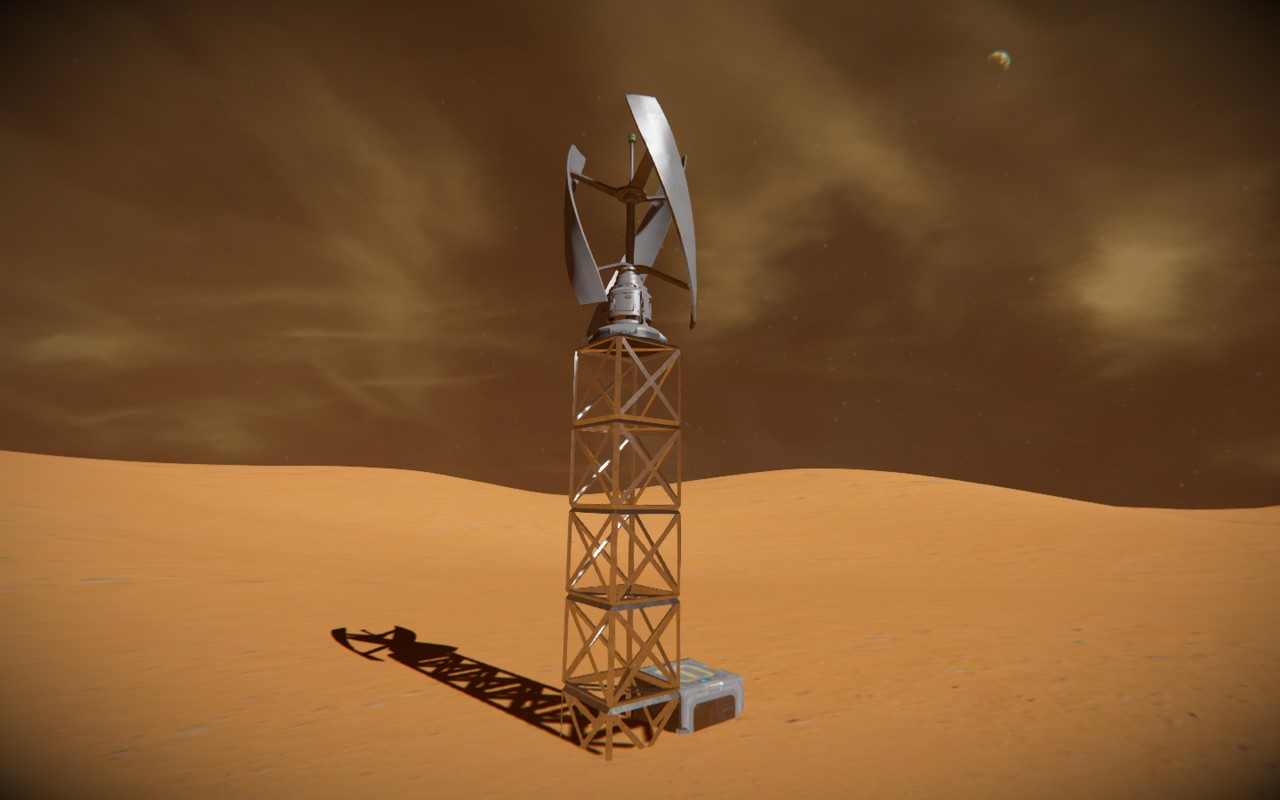
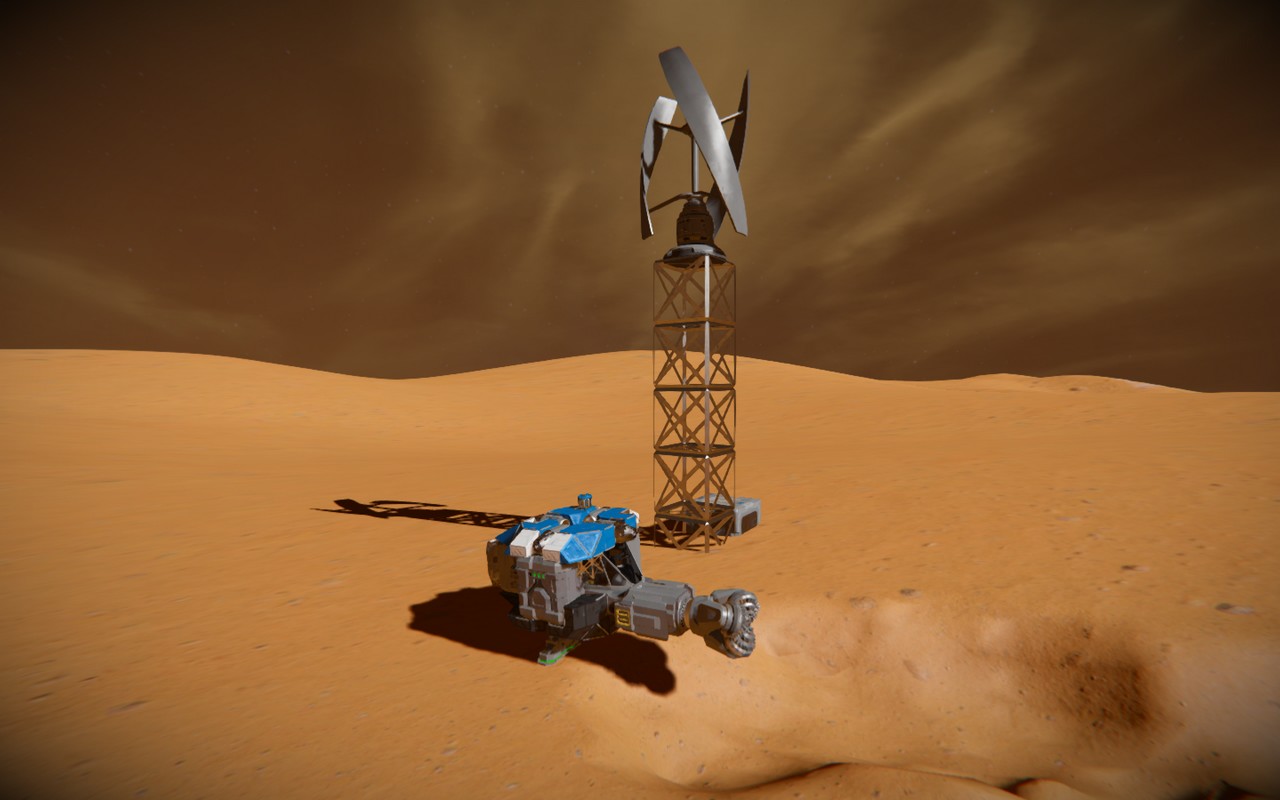
Starting base
1. Build a basic assembler with the conveyor up and through the block to the left of it the battery
2. Set up a wind turbine to be lifted off the ground with a few armor blocks
3. In the assembler we order production:
- 100 power cells
- 100 steel plates
- 150 building components
- 50 computers
- 50 motors
- 5 large steel pipes
- 5 screens
4. Cut off all remaining armor blocks on the capsule
5. Cut the Survial Kit from the capsule and install it on the base
6. Wait for the end of production and weld the battery
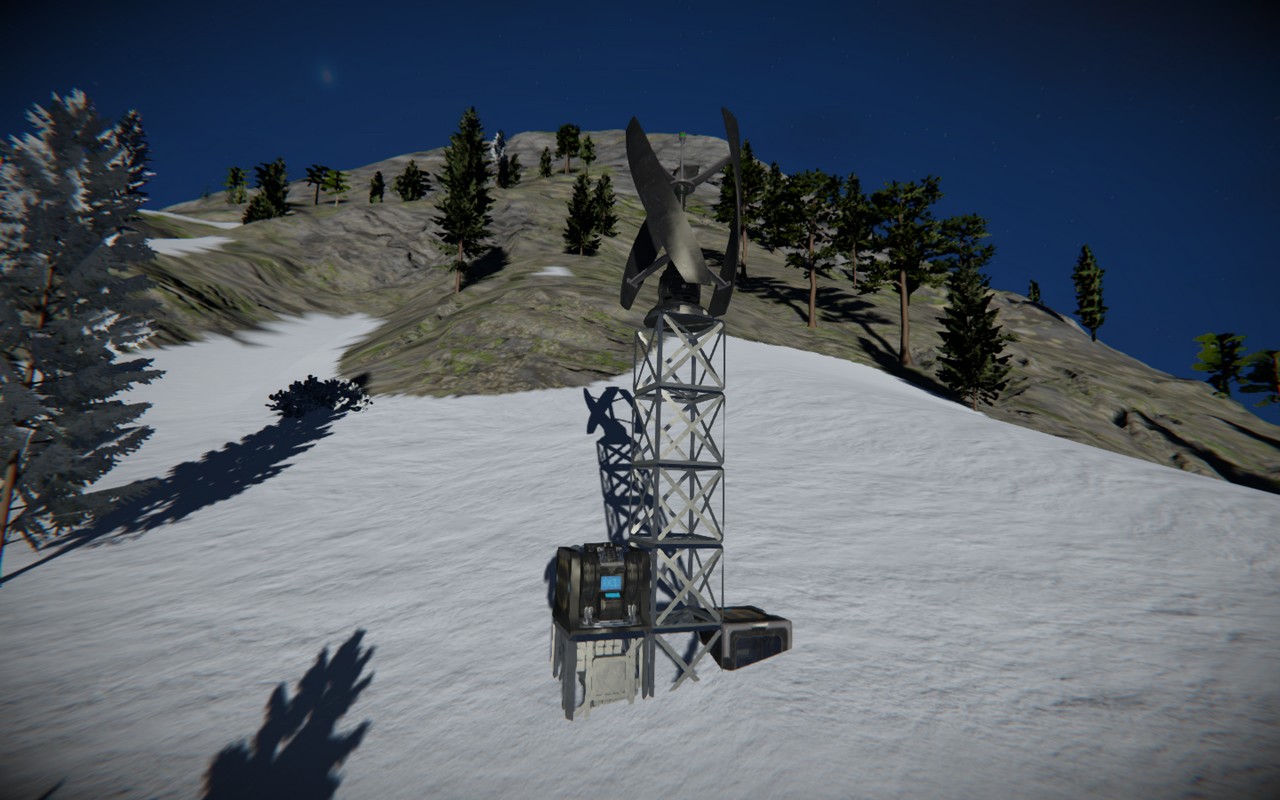
Starter miner
Since the mining of ore will go under the surface of the planet, the miner must be placed behind the drill in the frontal projection. To do this, it is necessary that it fit into the size of 3×5 blocks with the central location of the drill:
1. Add three full small conveyors to the cockpit conveyors and put the generator on them, docking at the ports
2. Behind the generator we install the middle container, behind which we put a new battery in charging mode
3. From the 8 gratings available, we build a gyroscope and atmospheric thrusters: 2 up, 2 back, 1 along the other axes
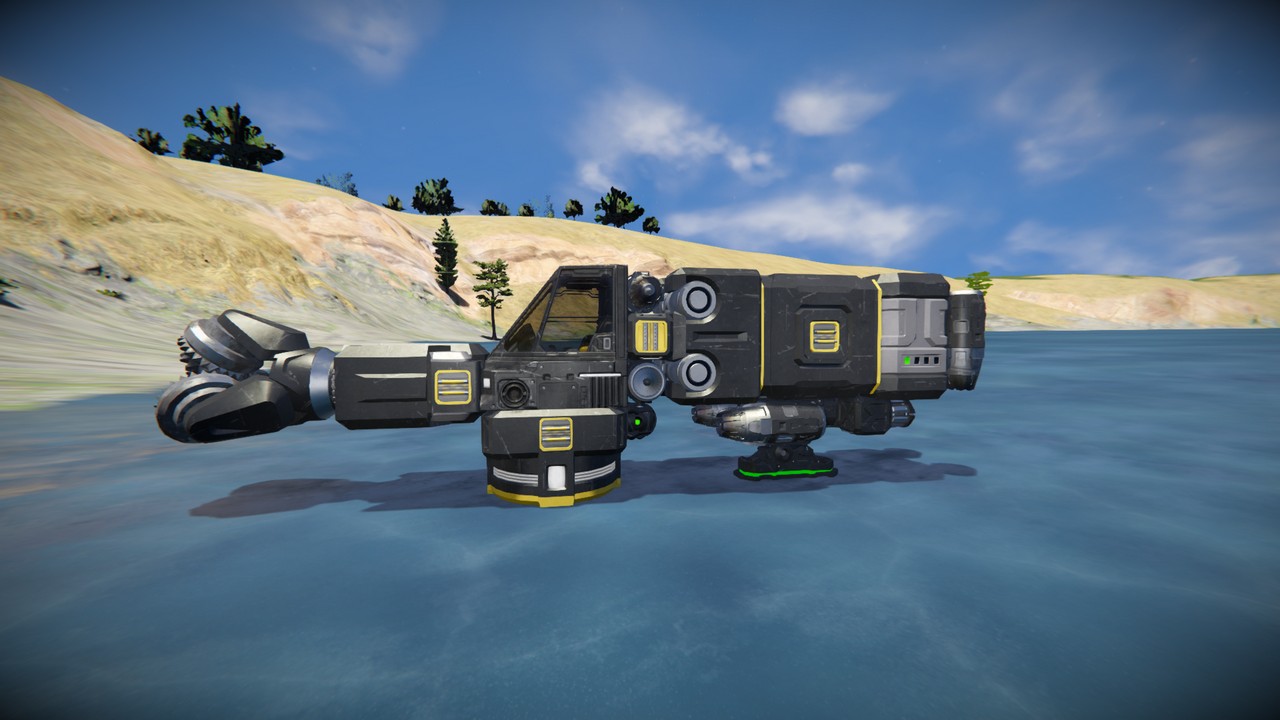
Atmospheric miner for planets
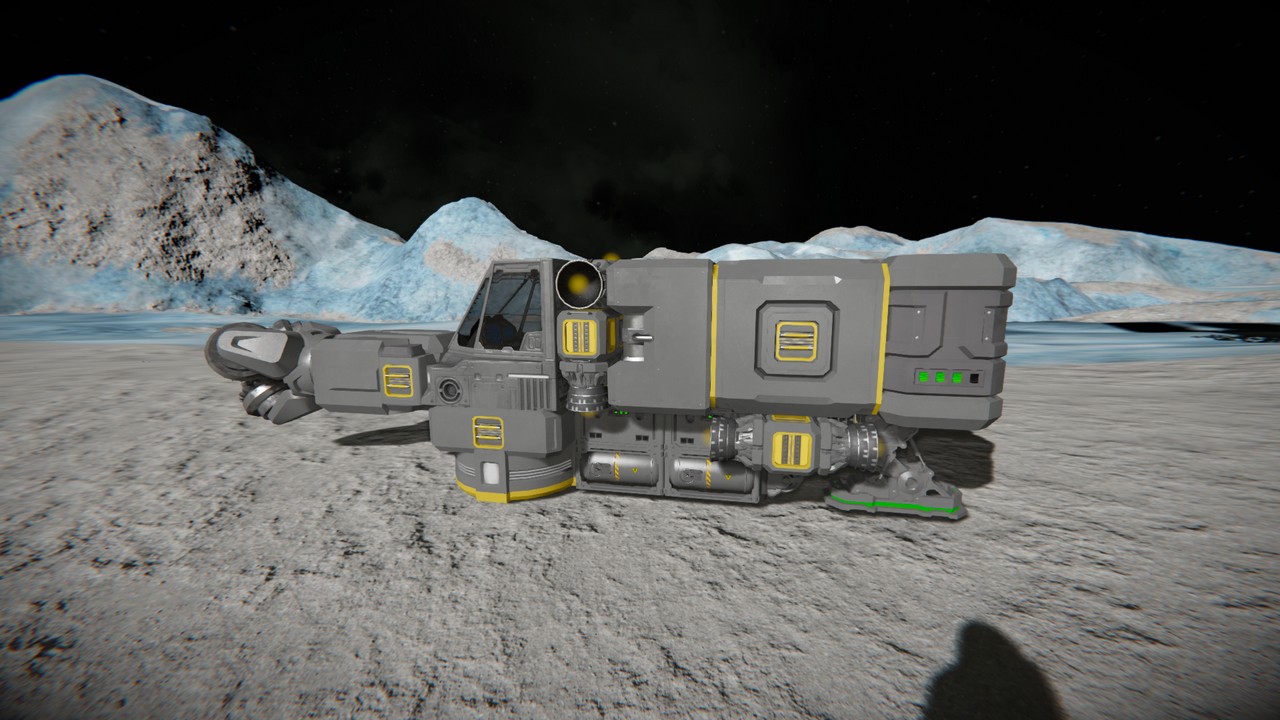
Hydrogen Miner for the Moon
Now you have a miner that is able to dig up and hold a full volume of cargo in the air and drill under the street up to 45 degrees. You can fill the cylinders in the generator from the outside through the small ports of the container.
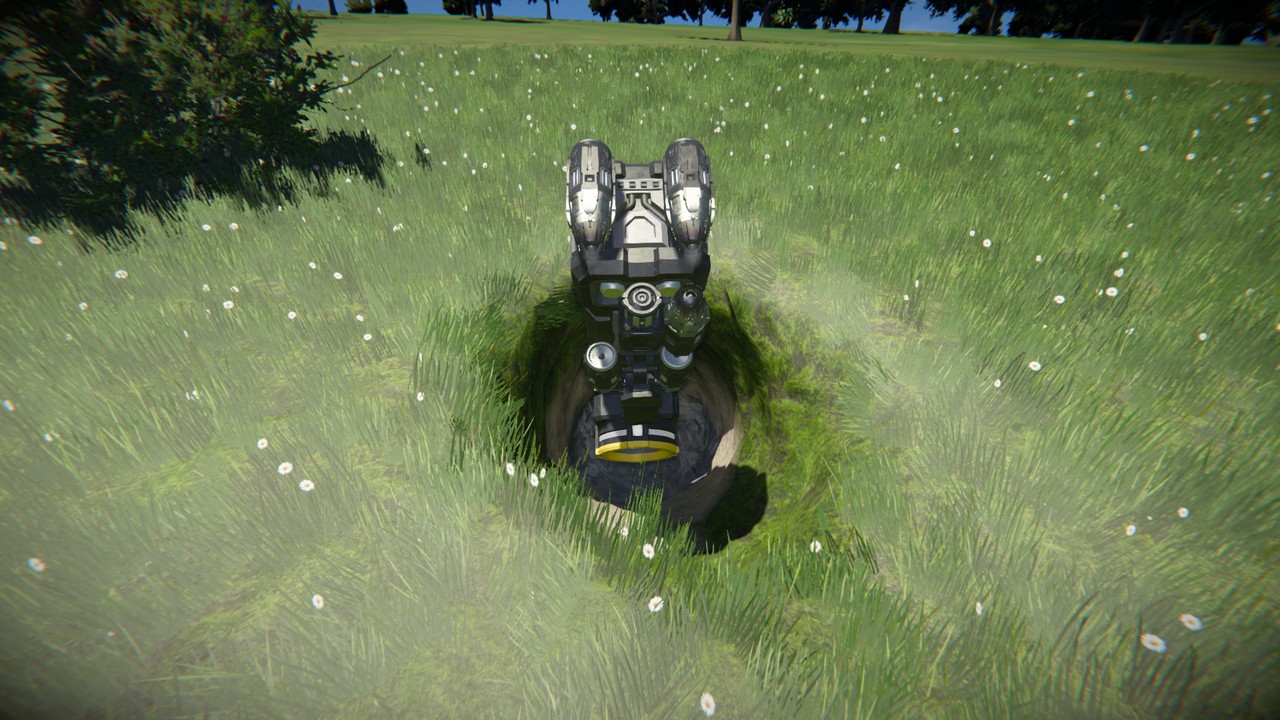
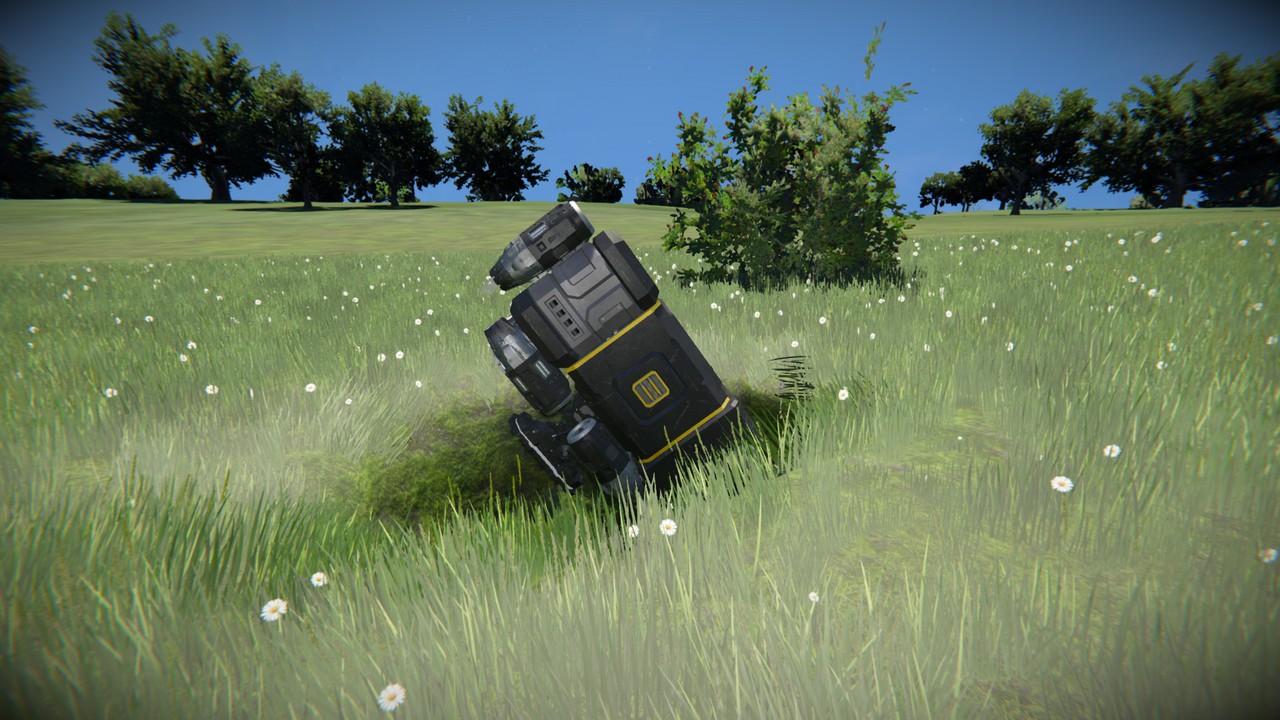
If you didn’t find ice at the very beginning of survival, you can find it with the help of a miner. Its autonomy should be enough for about 45 minutes of flight, which is quite enough to visually find ice even on Pertham. After that, return to the base and cut it down completely. The carrying capacity and volume of the cargo miner is enough to transport the base to a new location closer to the ice.
Cobalt
Without cobalt, it is impossible to produce metal grid that are needed to install the assembler and further expand the progress tree.
Finding cobalt requires an ore detector, and in order to be able to build it, you must first install a basic refinery on your base. Therefore, we build an intermediate base:
1. move the turbine column to the left and add 2 wind generators
2. put the base refinery in its place, and immediately after it the conveyor
3. install the connector on the base conveyor
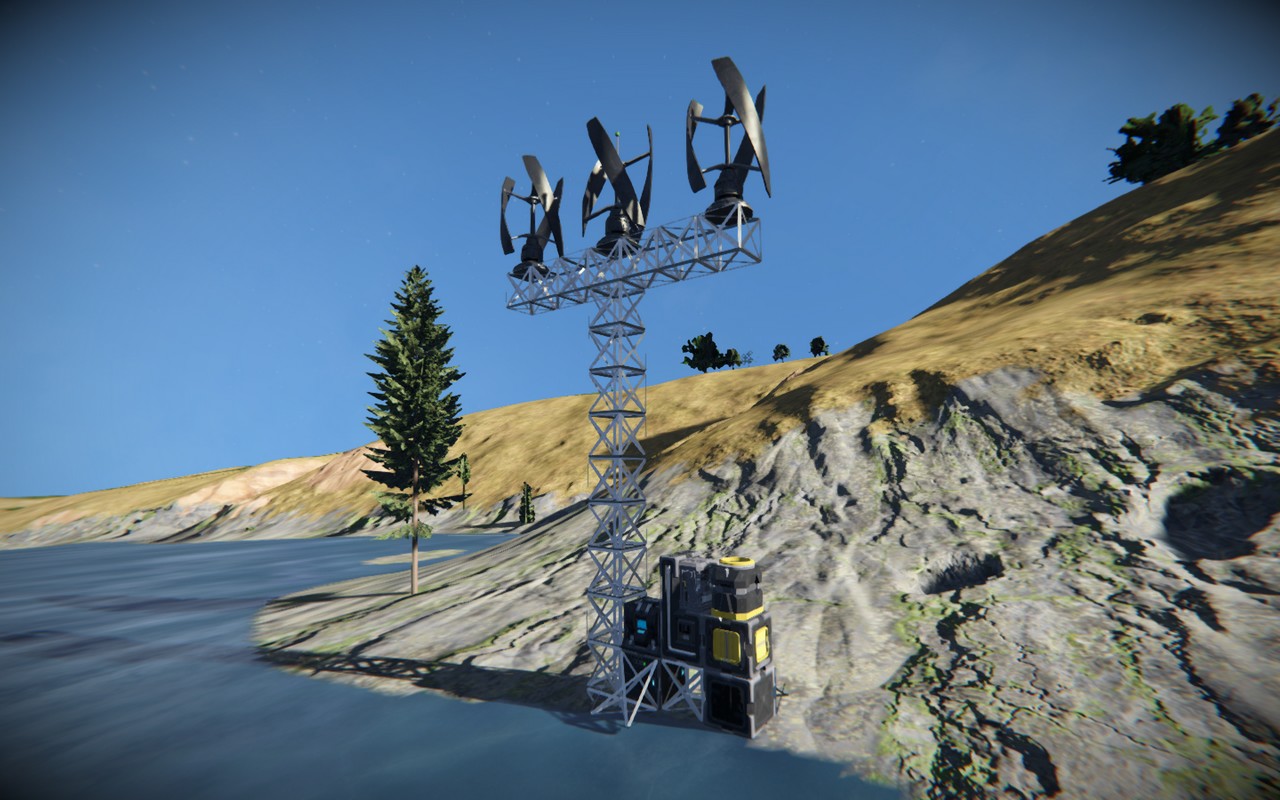
If there are not enough components for production, then the miner can dig up another stone and start the production of ingots in the Survial Kit by loading it manually with a stone. Install a small detector on the miner and change the search range to 50 m.
Now you can fly in search of cobolt and other ores. Before the flight, I recommend loading the base cleaner with stone so that its processing goes in parallel with the reconnaissance of the area and do not forget to set the GPS tag at your base.
Large detector
If you’re unlucky and don’t find cobalt within a radius of two or three kilometers from the base, then most likely the 50 m search bandwidth of a small detector is not enough to cover a large area. In this case, you can install a large detector on the miner. To switch from a small grid to a large one, you need to:
1. install a small rotor on the roof of the miner in the center of the container
2. cut off the small head, throw the large head onto the rotor from a small height
3. get into the cockpit and in the Terminal in the rotor settings press the “Attach” button
4. Weld a big head and install a big detector on it
5. align the detector along the longitudinal axis of the miner by turning the rotor and block it
6. move one thruster from the “back” direction to the “up” direction
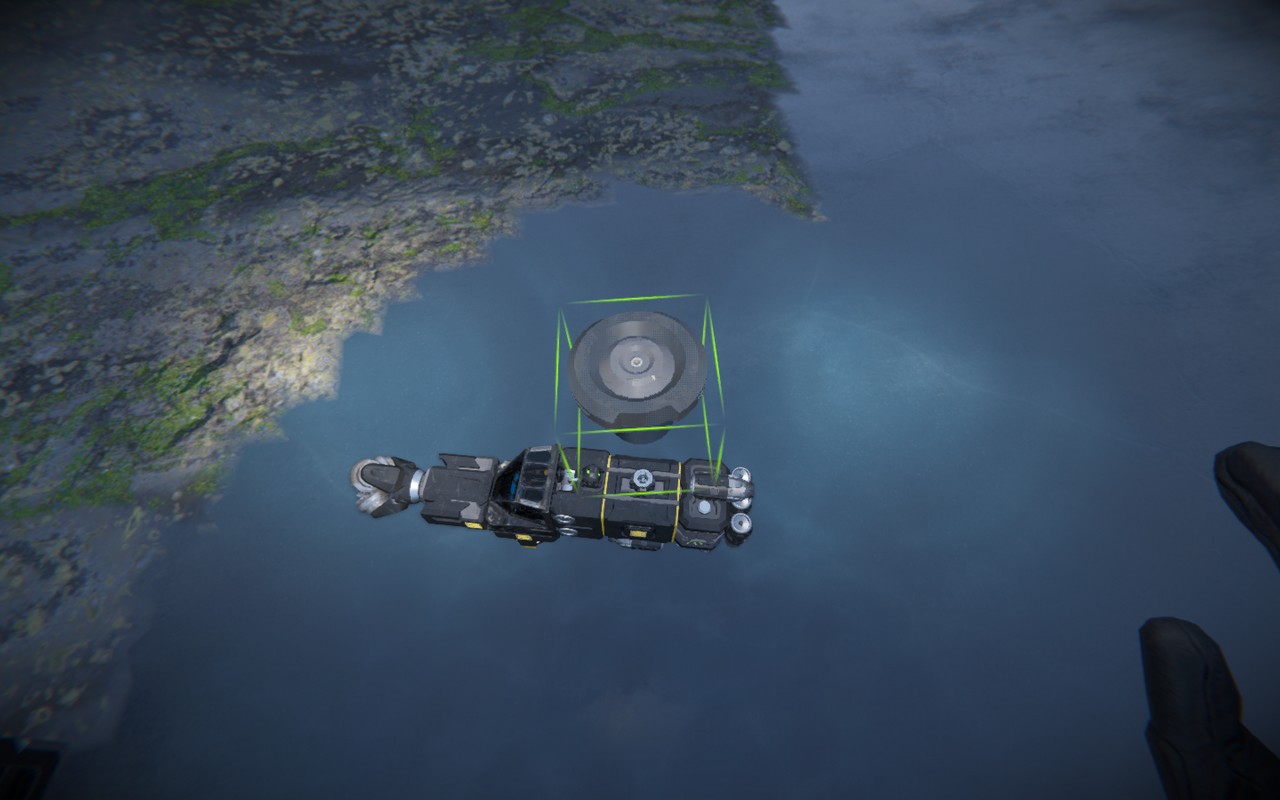
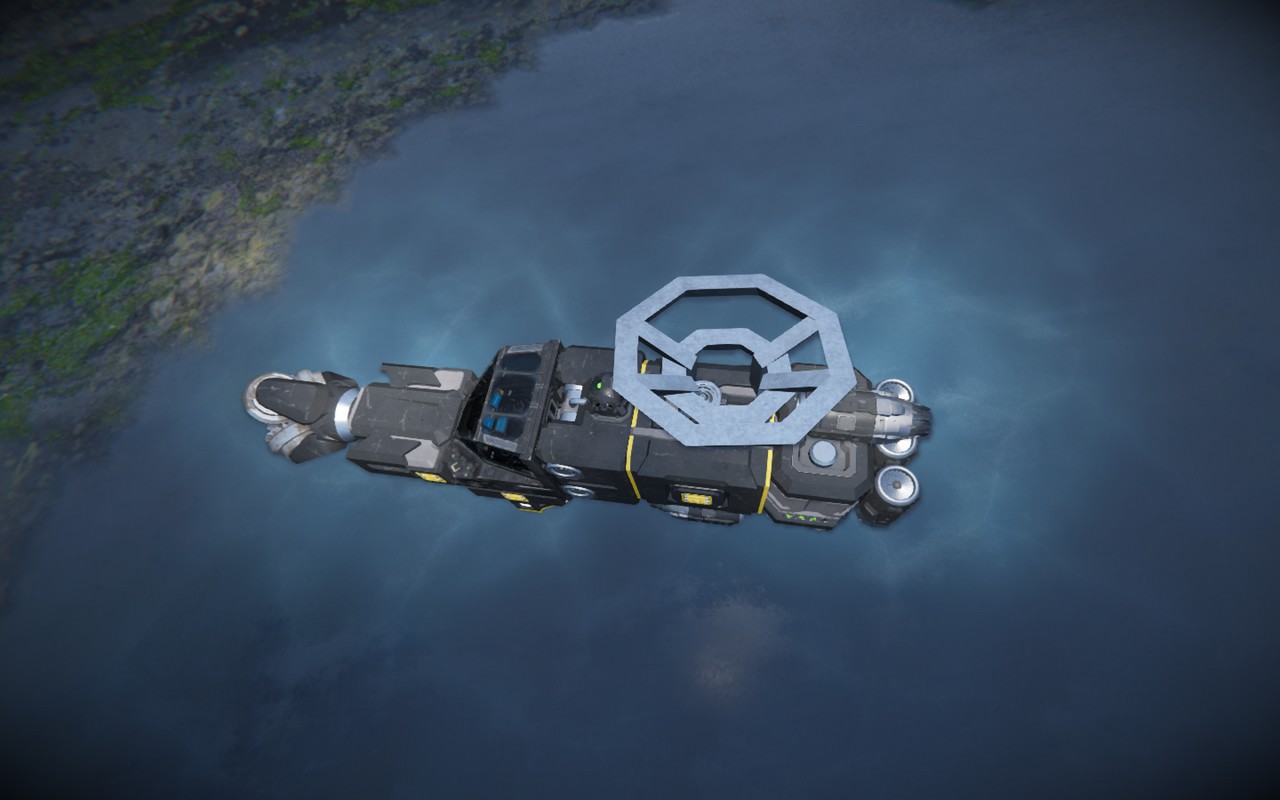
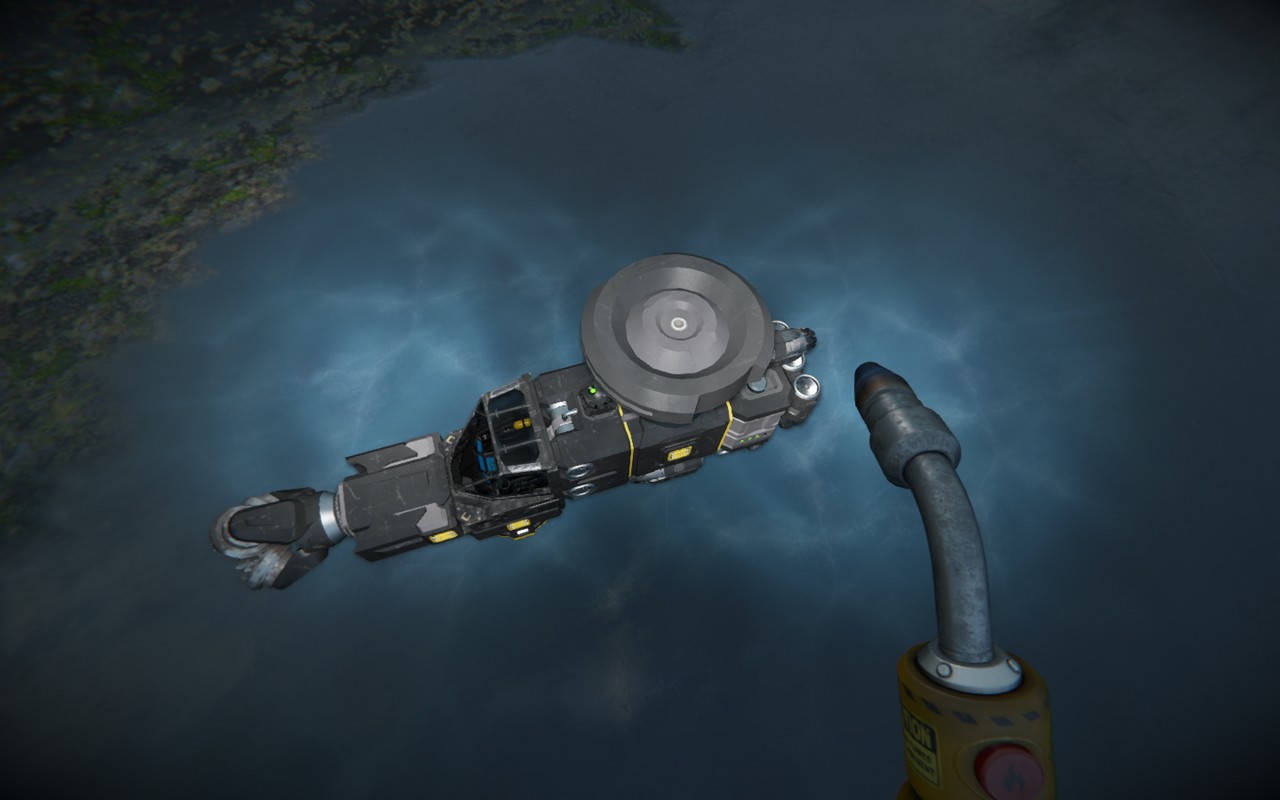
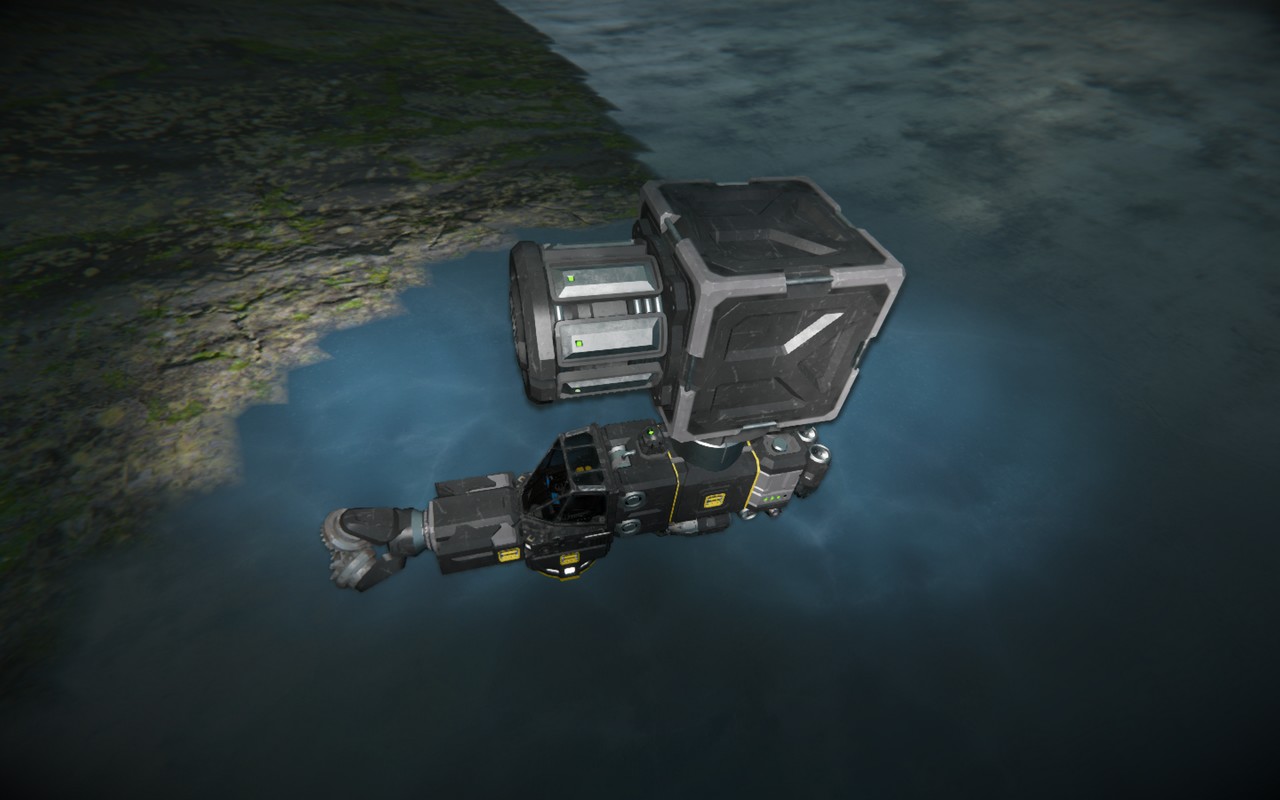
Now set the search radius of the detector to 150 m and take off for reconnaissance. In flight, the miner will constantly slowly descend, not due to lack of thrust, but due to the game mechanics for such a build, so you will have to constantly steer the lifting thrusters to maintain altitude. You can save the game and log in again so that this effect disappears and the miner stops “sagging” in flight.
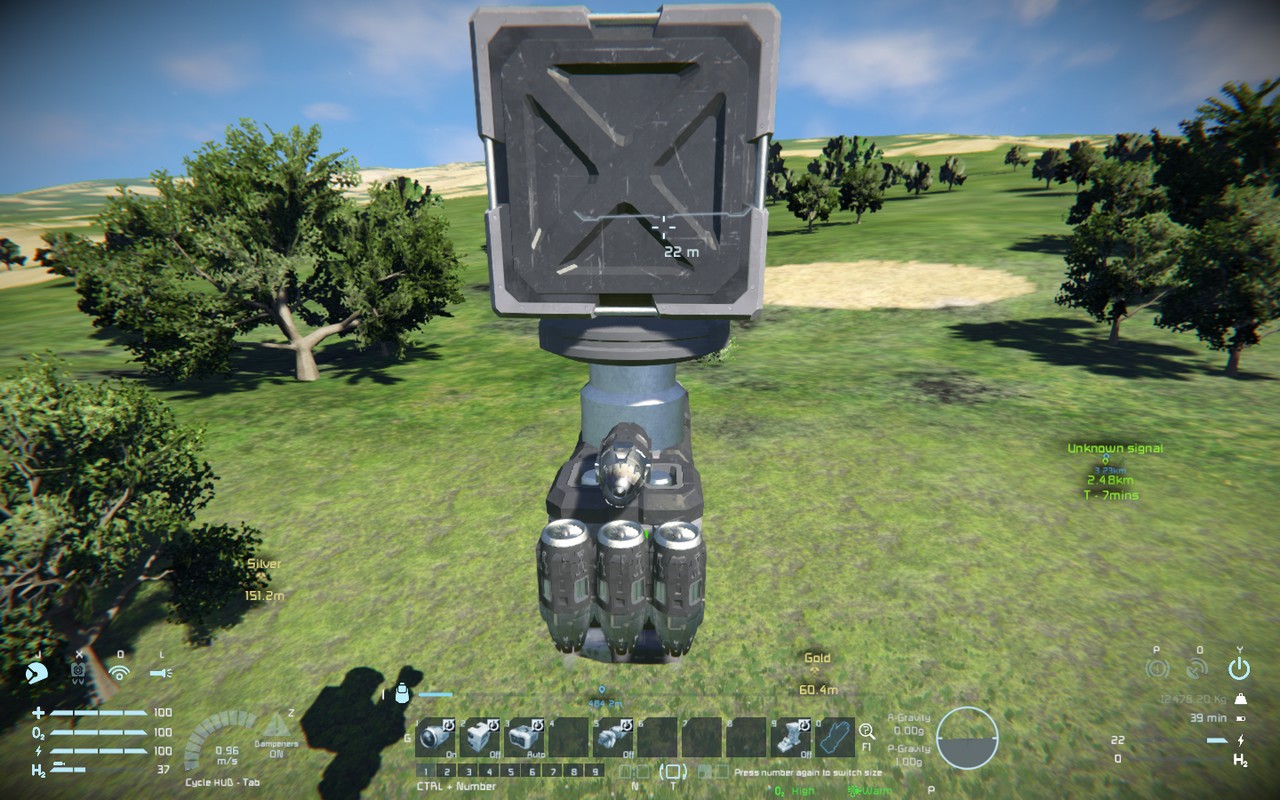
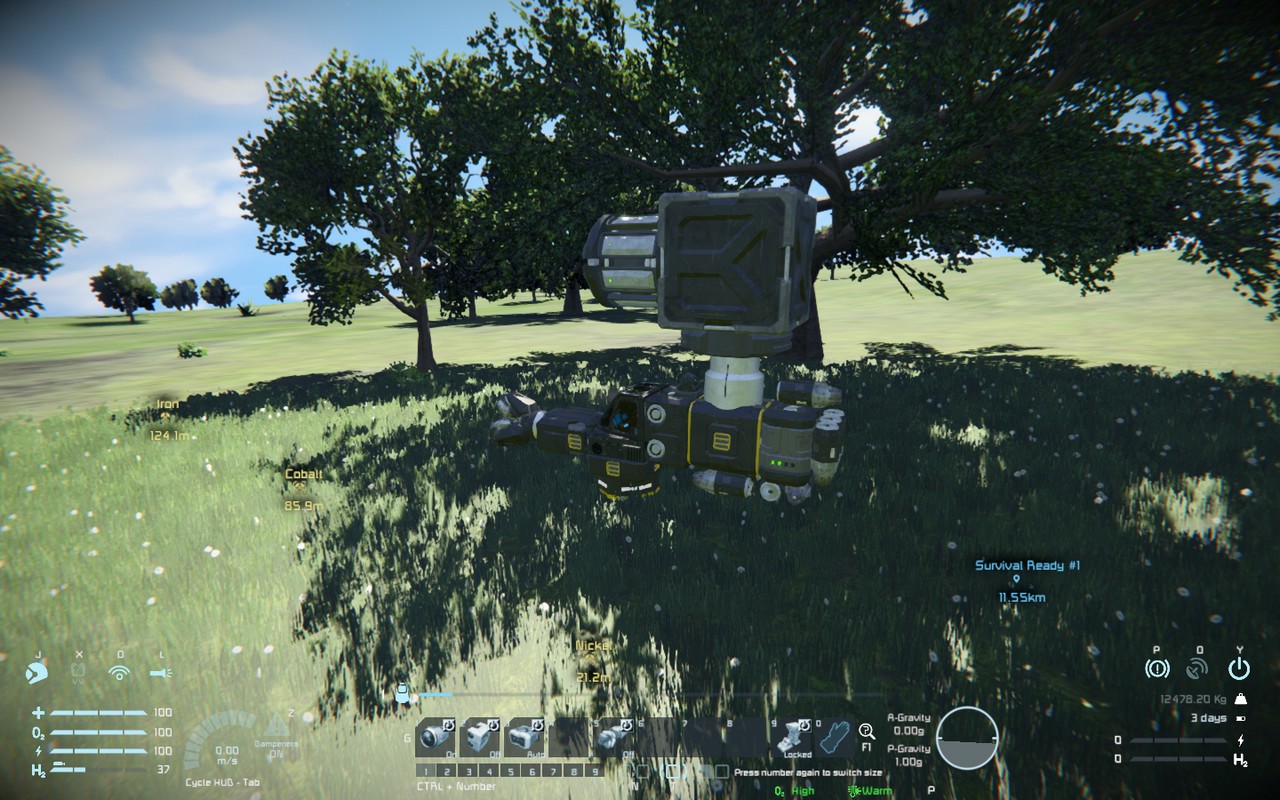
As you can see in the screenshots, a large detector allows you to find ore at a depth of more than 50 meters. Now you will need to break through the adit to the deposit using a hand drill in the stone destruction mode, focusing on the mark on the screen and place a GPS marker over it. Thus, you can quickly find all types of ore, except for uranium.
Regular base
To finally unlock the progress tree and access the processing of all types of ores, as well as the production of all types of components, you will need to build an assembler, a refinery, a hydrogen tank, an interior wall block and a lighting lamp on the base.
To complete the functional design, you can add a small container, an O2\H2 generator, and a small hydrogen tank to the base, and set the modules to speed on the open modification ports of the faucet and refinery. In this form, the base with the Survial Kit installed will be a respawn point where you can continue to survive if you fail fatally in space.
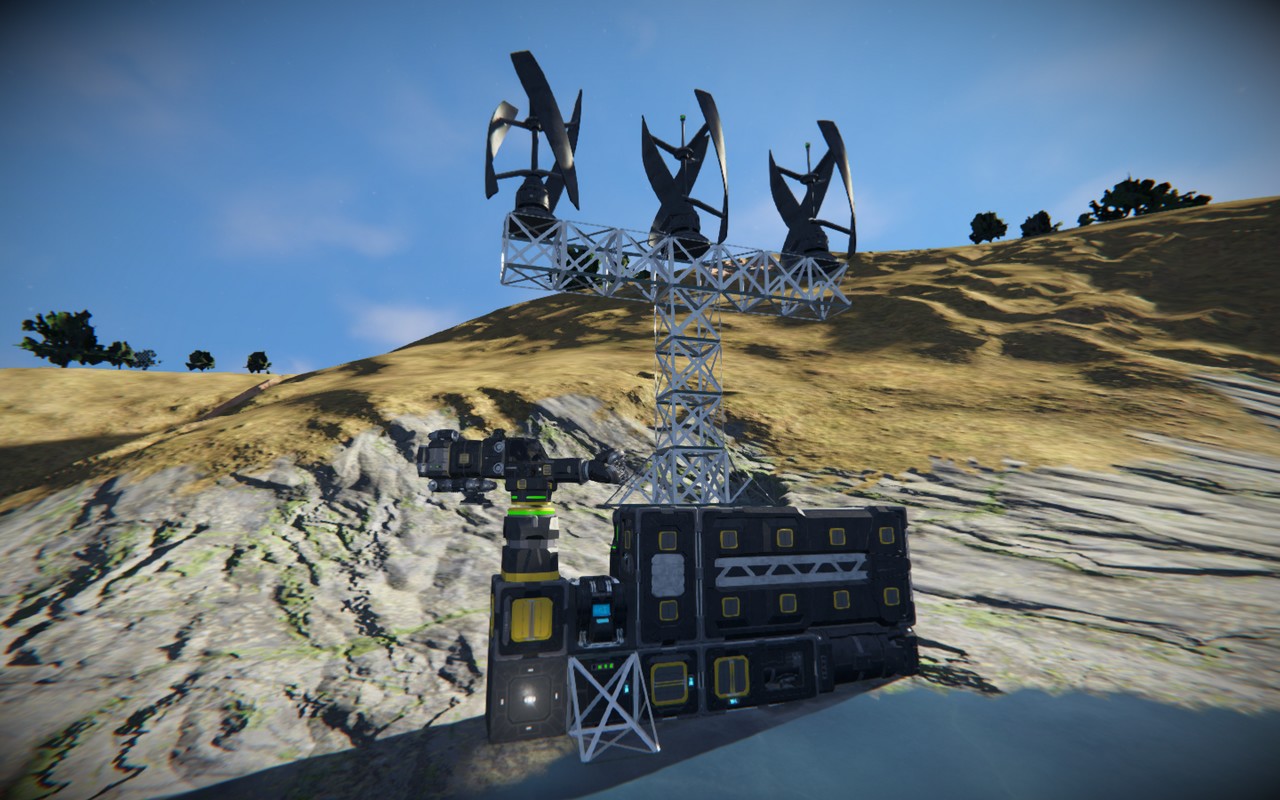
This is the most compact version of a full-fledged base, which can then be sheathed with armor and expanded with side conveyor ports, adding, if necessary, automatic turrets for defense.
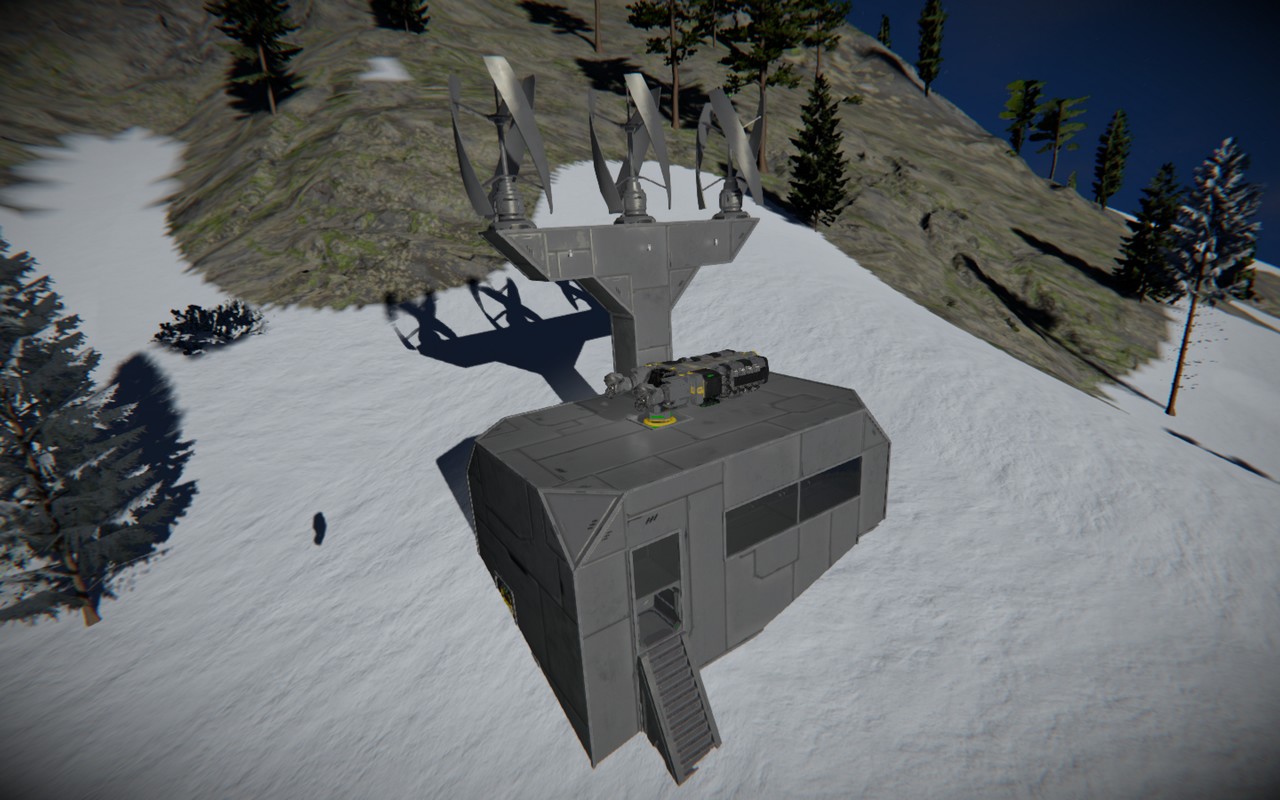
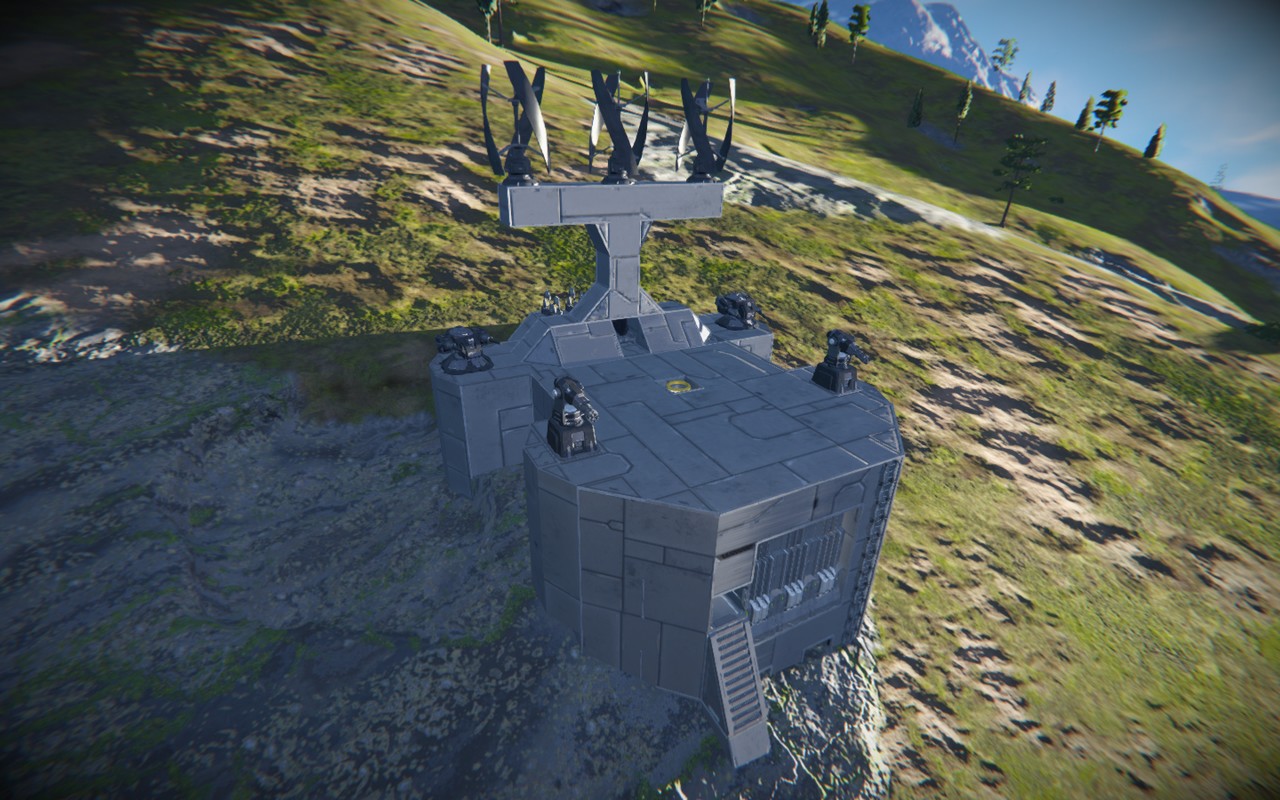
Spacewalk
To go into space, you need a hydrogen-powered ship, on which it will be possible to put ingots and a supply of hydrogen into orbit. I use a simple and versatile solution that can be easily built by hand and modified to your liking.
Solar panels may not be installed. On top of such a hydrogen processing platform, you need to install 4 hydrogen O2 / H2 generators and an energy generator that will not allow the batteries to run out. The platform can extract ice from a relatively flat surface and immediately process it by filling hydrogen tanks. Then the generators can be removed, and go into space from any of the vanilla planets if the total mass of the platform with the cargo does not exceed 220 tons.
Survival on Europe
Europa is a satellite of Mars, which differs from other planets and moons in that there is no stone on it, but only ice. To survive on Europa, you can look for pure ore deposits in the form of rocks on the surface, but this can take a long time, so here you will need a hydrogen thruster that is installed on the capsule with which you can fly to the nearest asteroid in space.
Before going into space, you will also need to modify the capsule during the disclosure of progress:
1. Incise and back-weld any chassis and cut down atmospheric thrusters
2. Cut the chair and part of the armor blocks from the nose so that the grinder can reach the blocks behind it
3. Incise and restore the small container and conveyor, and then cut all blocks except conveyors
4. Replace the conveyor tubes with complete blocks and install the remote control block
5. Put the gyroscope on the roof on the remote control unit
6. Incise the hydrogen generator so that the large pipes are in inventory
7. Install the drill inside the capsule, mating it with the convectors
8. Move away from the pod and press Shift+K to bring up the remote access menu
9. Select the Respawn Planet Pod and press “Control”
10. Detach the landing gear and tilt the capsule forward using the gyroscope
11. Turn on the drill for 2-3 seconds and stop it, this is enough to get 3-4 tons of ice
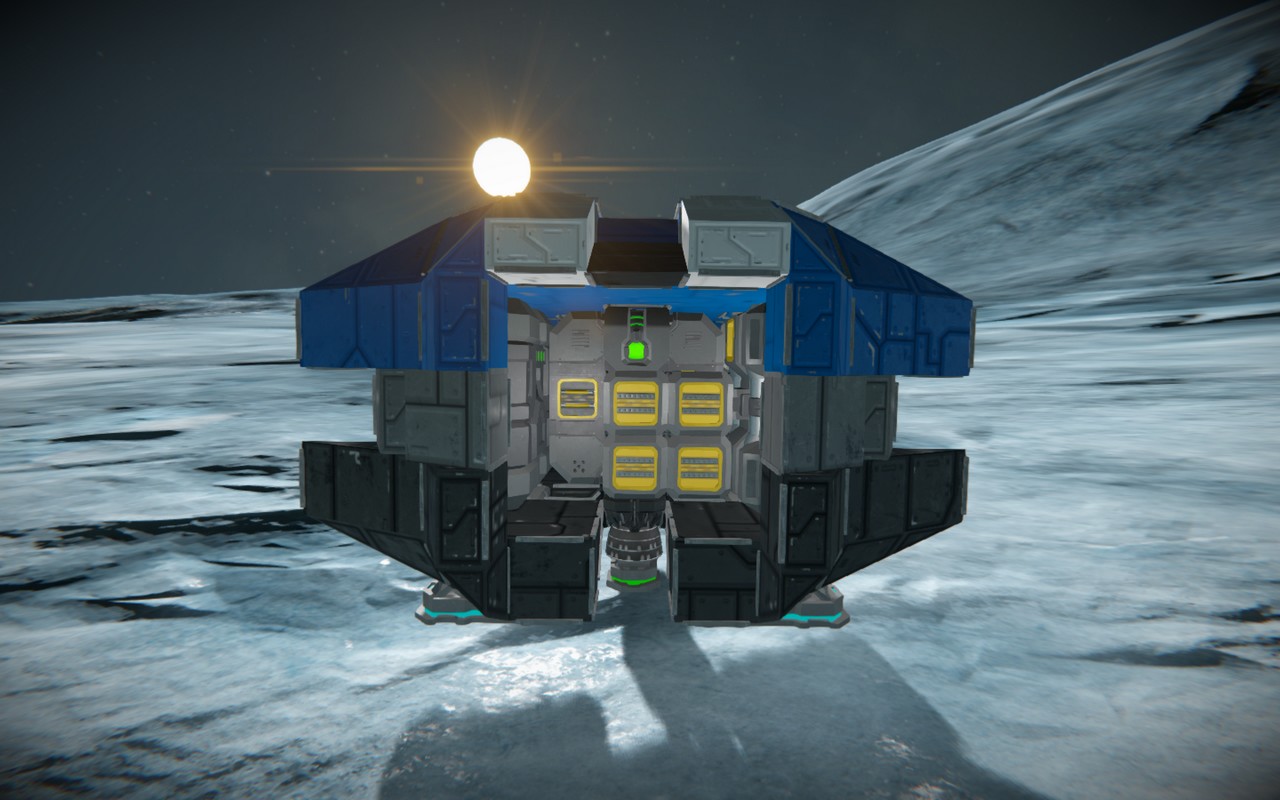
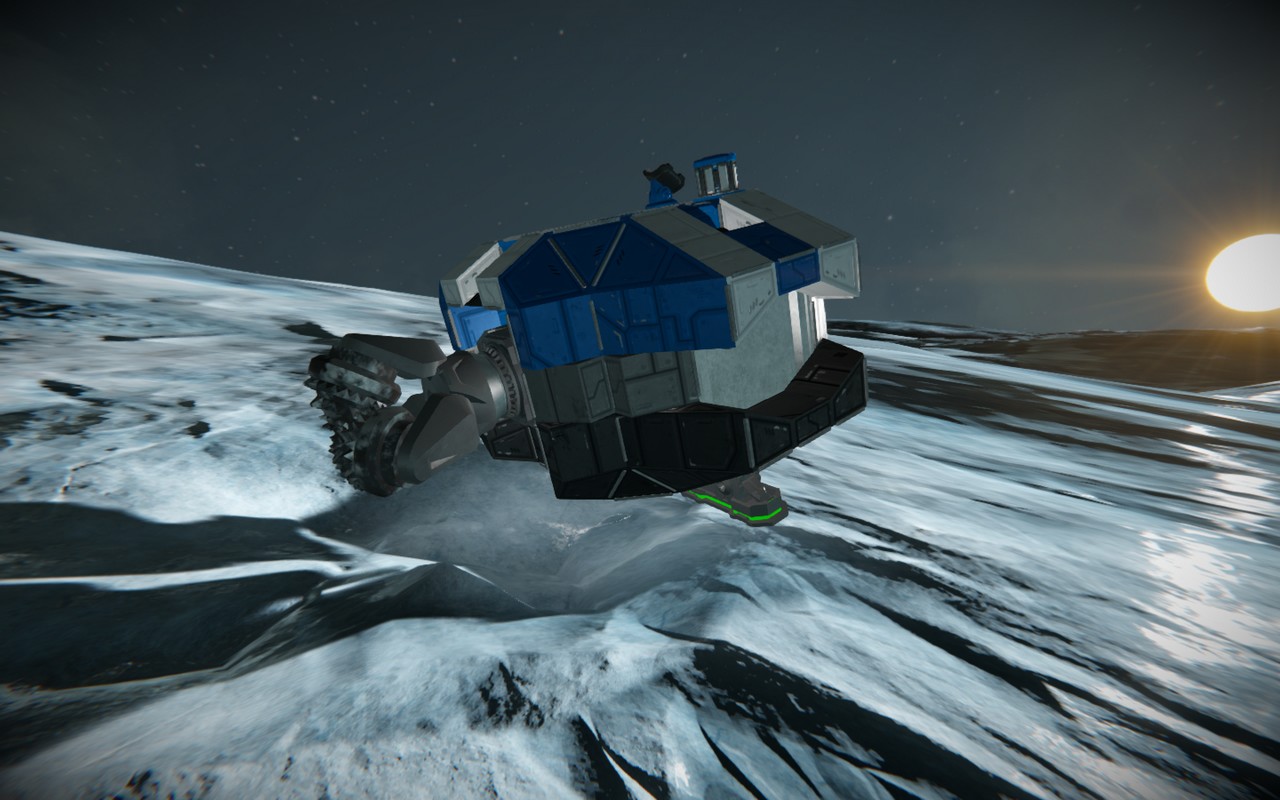
12. Exit remote access mode and collect ice from the drill through the Survial Kit
13. Cut the drill, restore the generator and reload the ice into it, put the chair back
14. Sit in a chair, return to remote control mode and turn on the hydrogen booster
15. Detach landing gear and take off vertically with maximum acceleration
After the gravity disappears, switch to “third person view” and visually look for the nearest asteroid. After you find it, turn off the speed by rotating the capsule with a gyroscope and redesign it for more convenient control from a chair, as well as add a parking chassis so that you can hook it onto an asteroid.
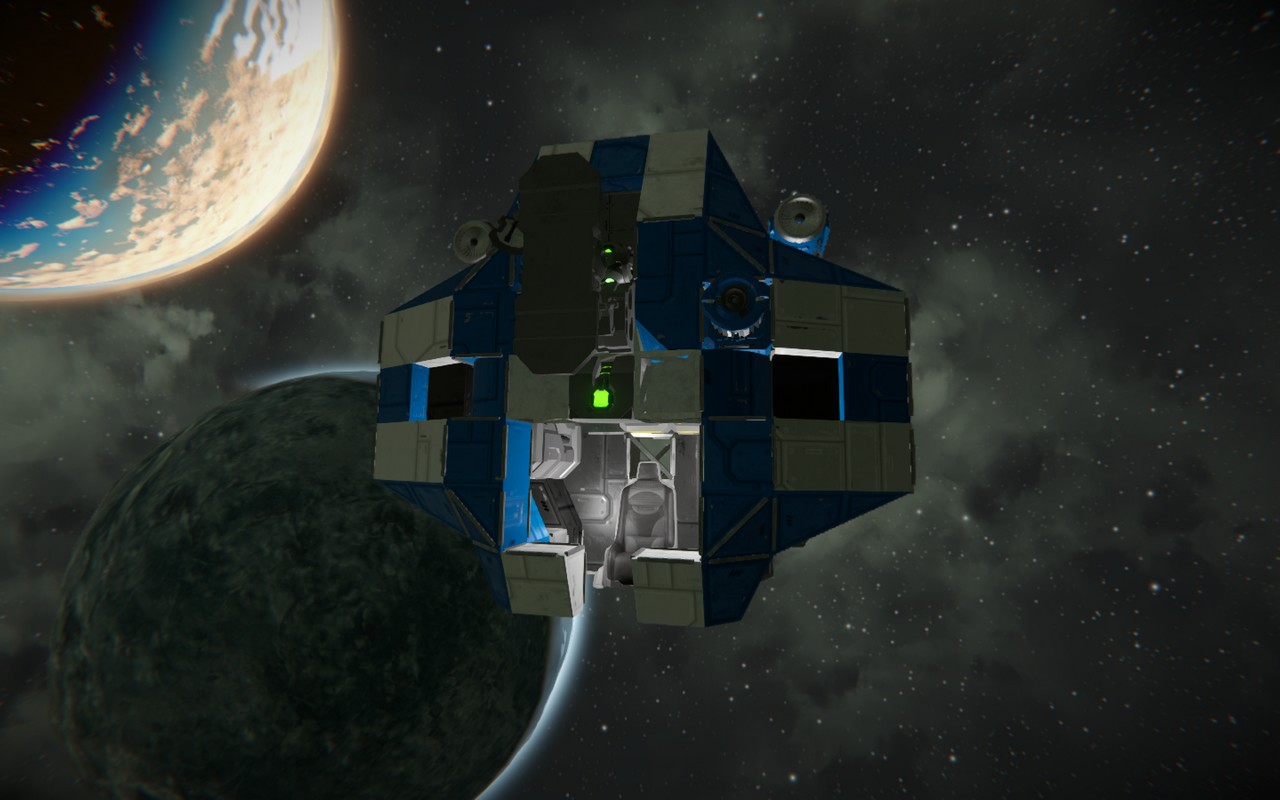
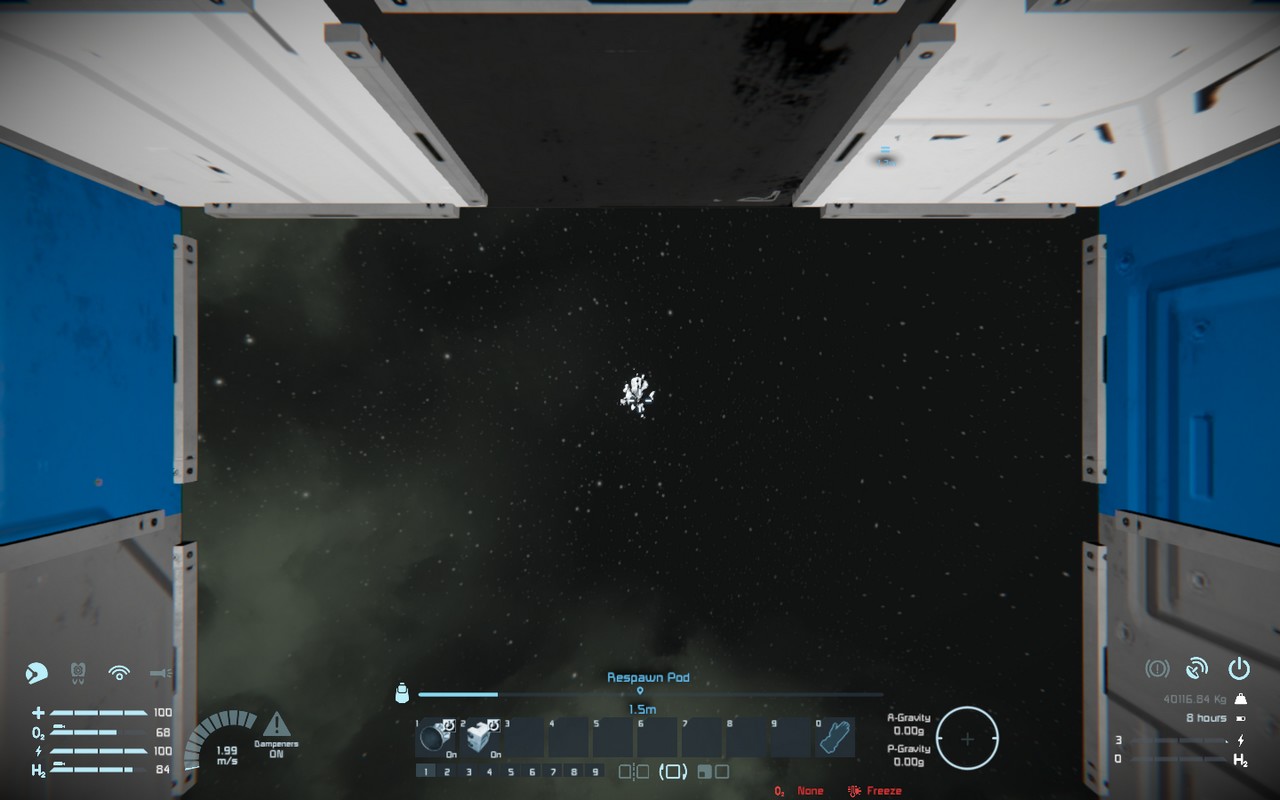
Then deploy the capsule and accelerate towards the asteroid. When approaching, slow down by turning 180 degrees. At the moment of contact, it should not exceed 5 m / s, so as not to damage the capsule. After the capsule is fixed on the surface of the asteroid, you can start mining the stone with a hand drill, or you can try to do it with an automatic drill. To do this, repeat steps 6 to 10.
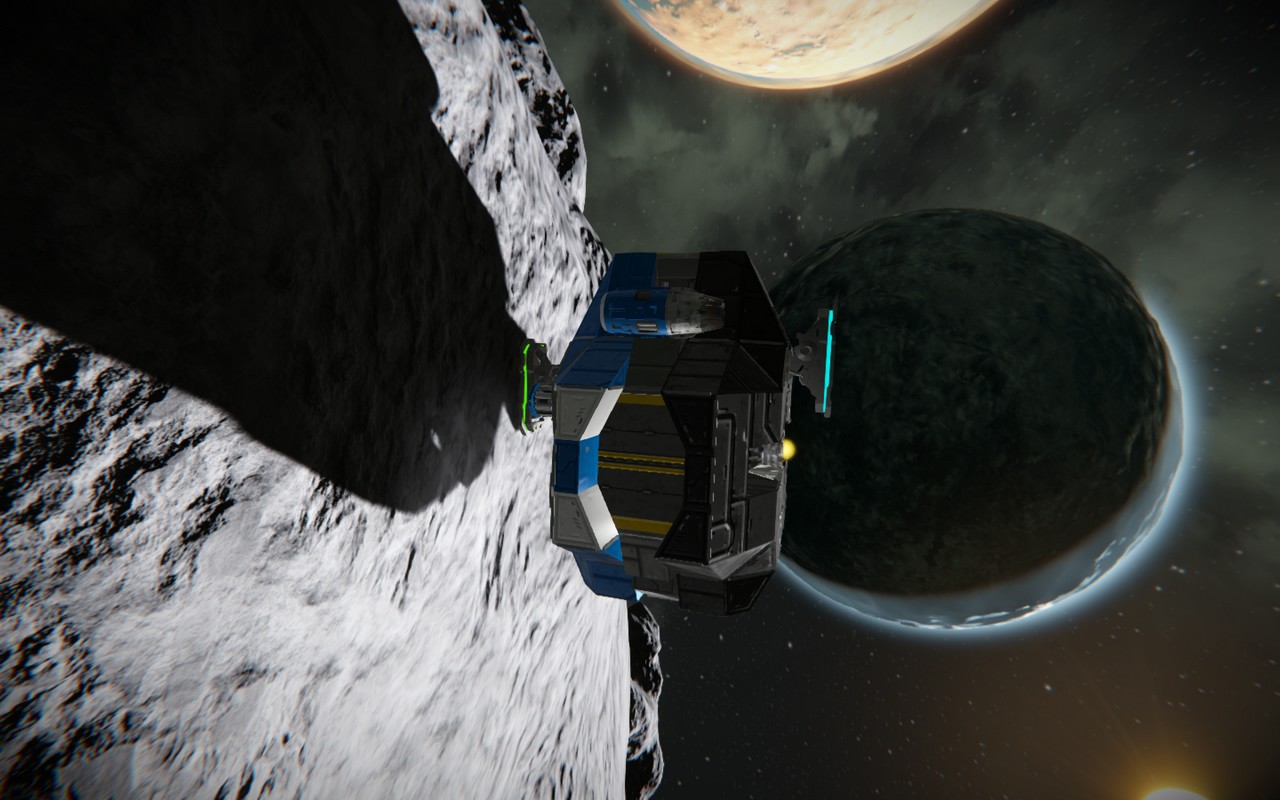
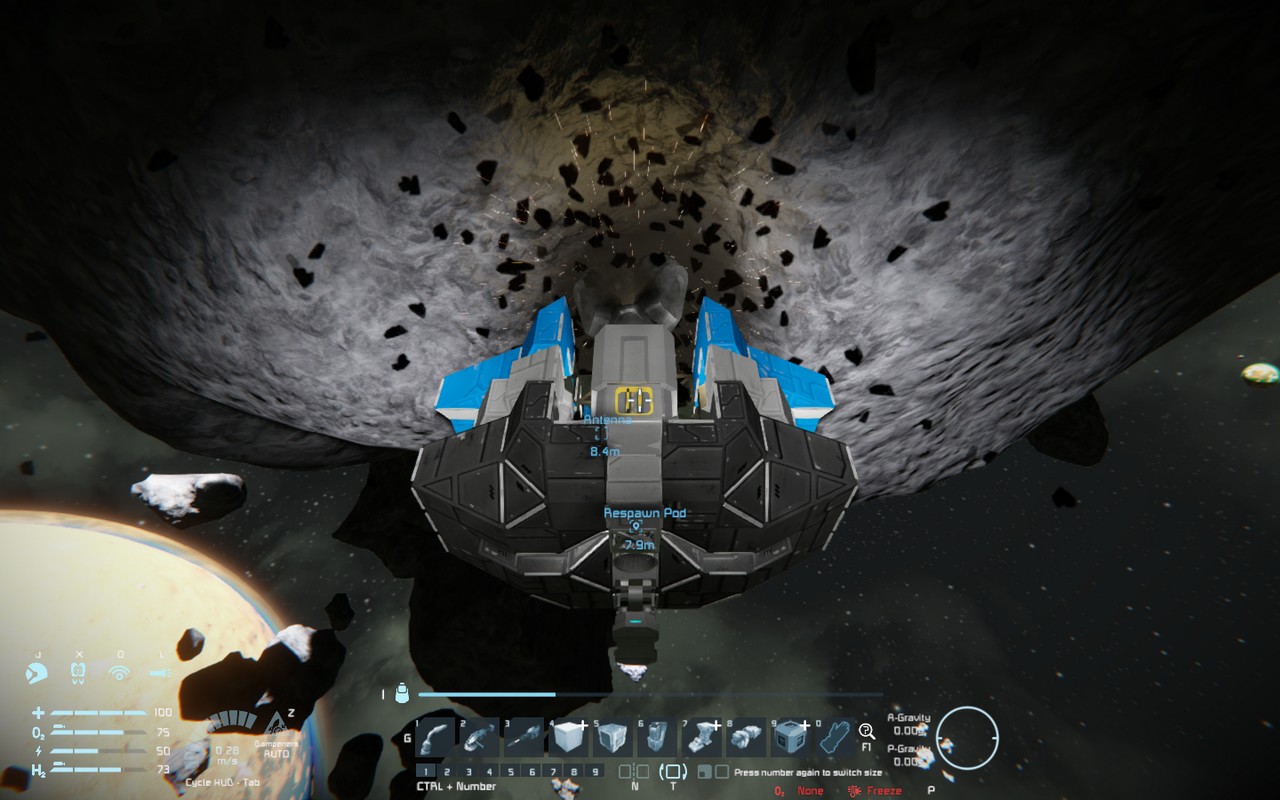
If the surface of the asteroid to which you are attached is flat enough, then the capsule should unhook from the stone that will be selected by the drill and begin to move along it along the way, producing a stone until it flies away from the asteroid. The speed in this case will be small and as soon as this happens, you need to stop the drill and restore the capsule as it was before the installation of the drill and stop the capsule by rotation.
In total, you will need at least 20 silicone ingots to build a large solar panel, power the base assembler from it, and produce the missing large pipes. After that, you will no longer need to cut the generator and you will have a controlled miner with one accelerator that can mine as much stone as you want. To deploy a staging base (see “Cobalt”) you need enough stone to get 750 gravel ingots.
To return to Europa, you need to remove the drill and restore the seat, then aim the capsule at the planet and accelerate to about 50 m/s. After landing, cut the hydrogen thruster in the environment and add the missing atmospheric thrusters along the axes. Then you need to deploy the starting base and look for cobalt.
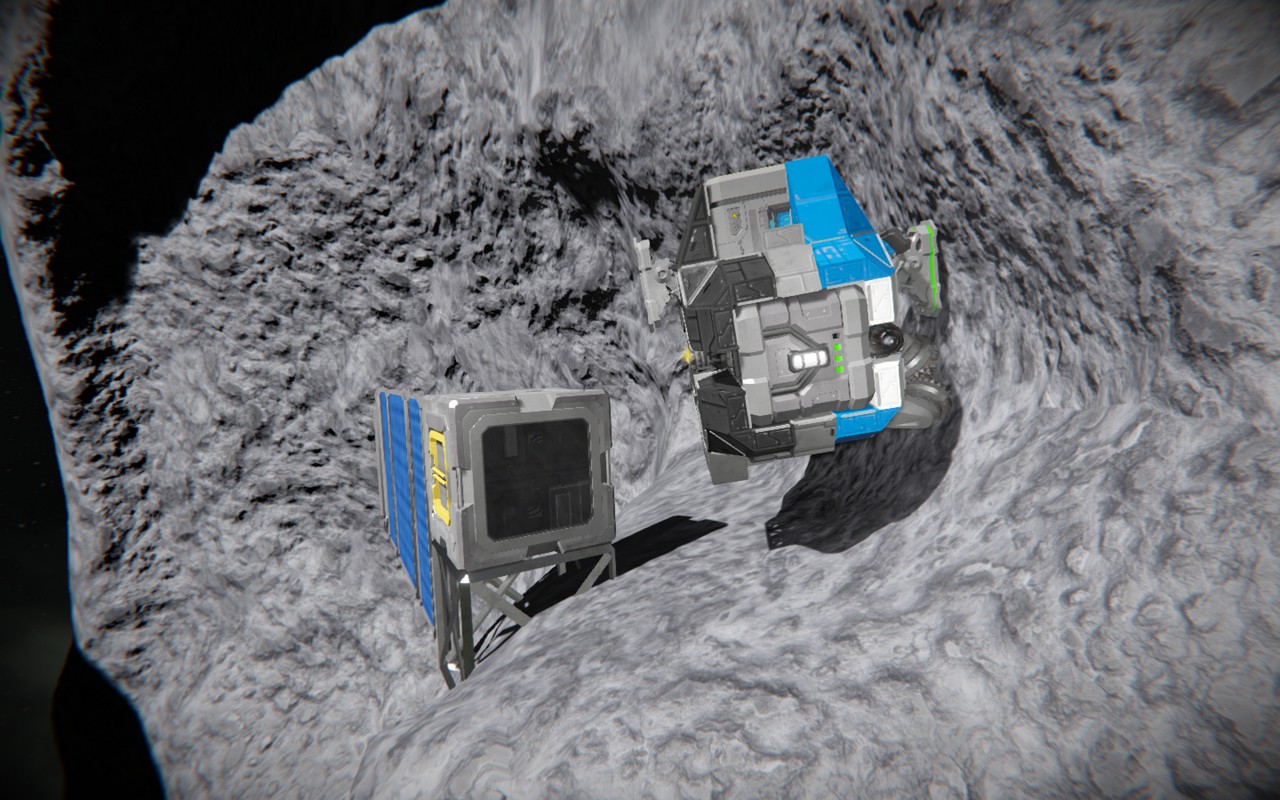
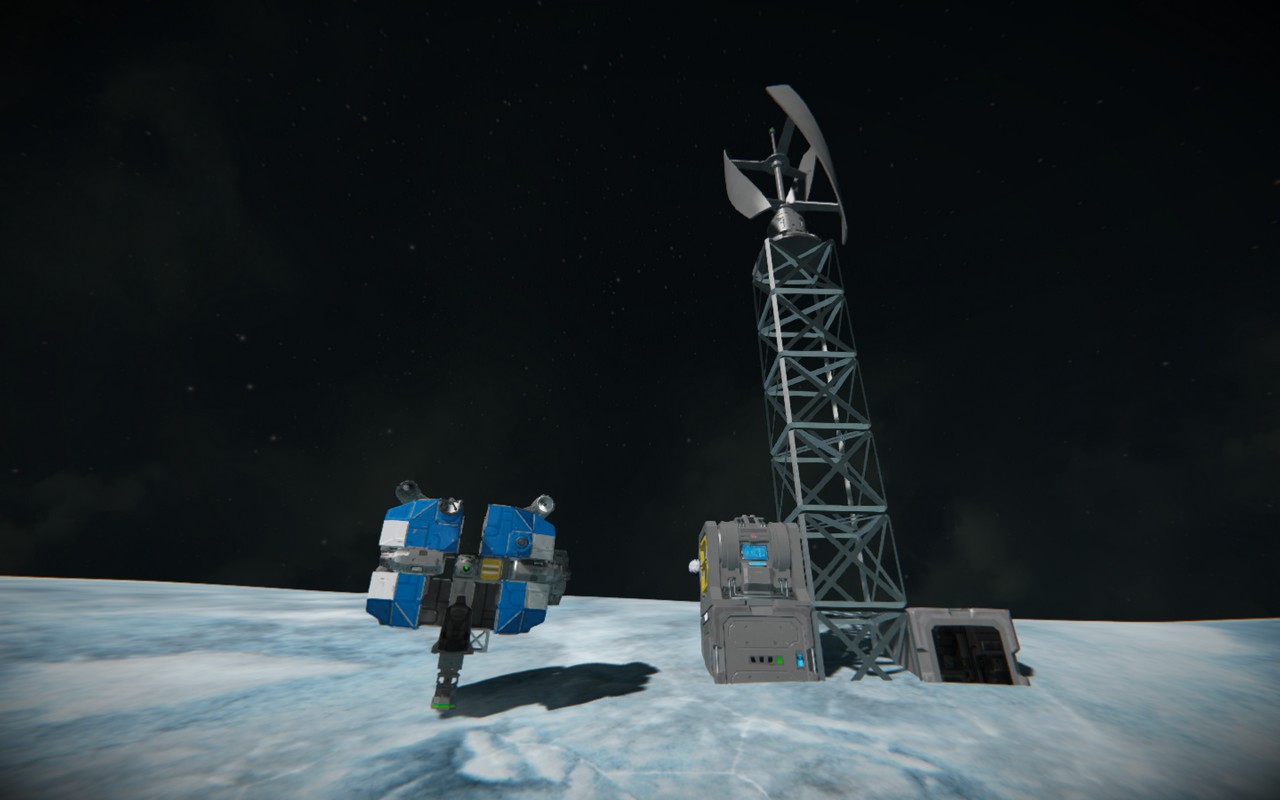
Survival on Moon
The moon differs from the rest of the planets in that instead of a capsule, you will be surviving on a rover that already has a cockpit and wheels from which you can cut large pipes while maintaining the ability to move. There is no atmosphere on the Moon, so atmospheric thrusters don’t work there.
To reveal progress, you need:
1. Cut off all atmospheric thrusters and notch 1 wheel 3 times
2. Remove the ice from the O2/H2 generator and cut it off
3. Cut off the near row of small conveyors located behind the generator
4. Incise, welding and cut a small container and install two complete conveyors
5. Restore the O2/H2 generator by docking it with the conveyor ports
6. Install anywhere on the rover chassis and then cut it down
7. Incise and welding the cockpit
8. Install the drill, take the missing components from the antenna and casing
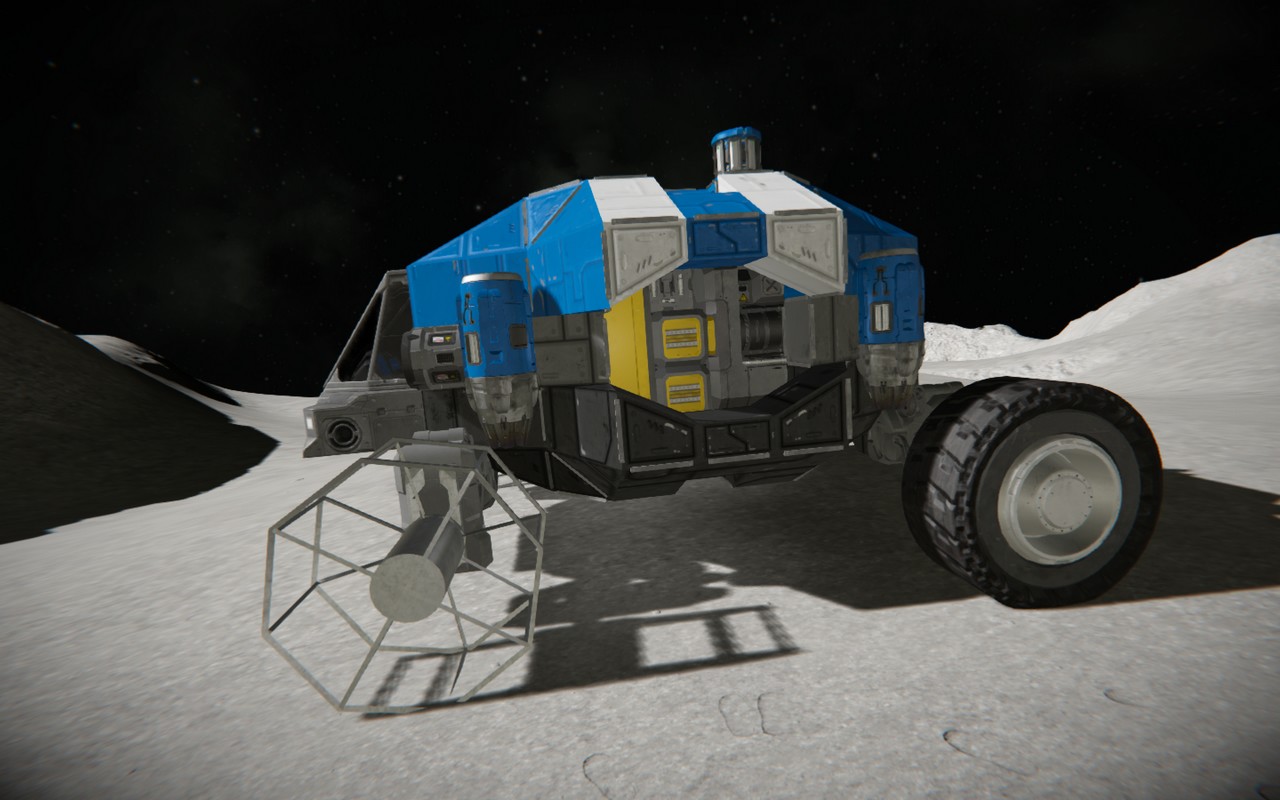
The moon is divided into two parts – one is relatively flat and has no ice, but there are many ore deposits. The other has a lot of ice, but the deposits are less common and it is covered with craters that are difficult to overcome on a rover. Ideally, you need to get to the border of these zones. For this:
1. Take the jetpack up to 2.5 km above the surface
2. Determine the direction of travel, go down to the rover and drive to the border of the zones
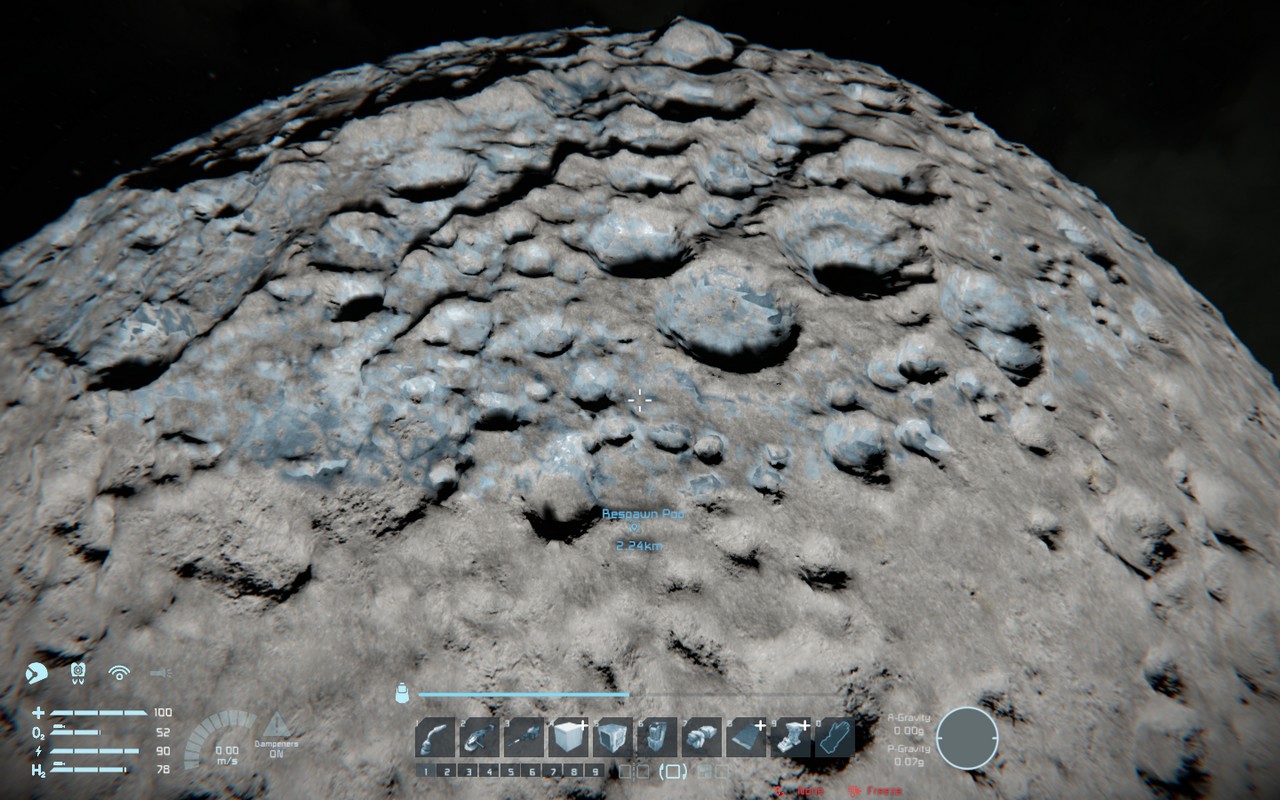
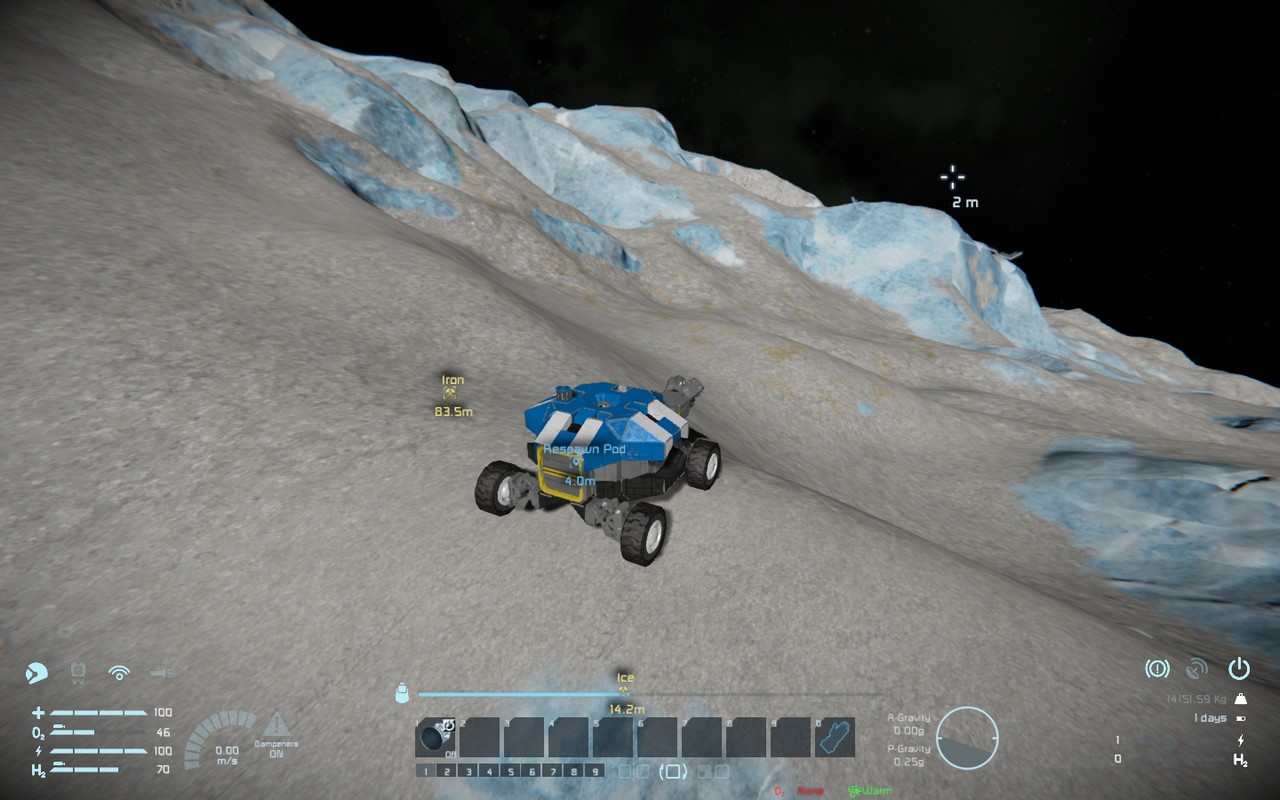
If the distance is too far, it is possible to fly to the border of the zones using a hydrogen thruster and 1 ton of ice from the generator. Before flying, set in the Terminal:
1. Hydrogen Thruster Interception = 0
2. Gyro power = 100%
You can fly on one thruster like a helicopter. The light gravity and the strength of the rover’s suspension will allow you to quickly adapt to this style of flying, you just need to watch the rest of the ice in the generator and land in time before it runs out.
Ore deposits on the surface will be marked with yellowish spots. Ore on the Moon is usually shallow, so exploration is easier to do just on a jetpack using a hand drill, its range is quite enough. The low gravity and the absence of an atmosphere make it possible to fly long distances.
The construction of the launch base is proceeding according to the usual scenario here, with the difference that solar panels are used instead of wind turbines. After the discovery of cobalt, the easiest way is to dig up 2-3 tons with a hand drill in order to start the production of gratings and rebuild the capsule into a hydrogen miner, which will provide further mining.
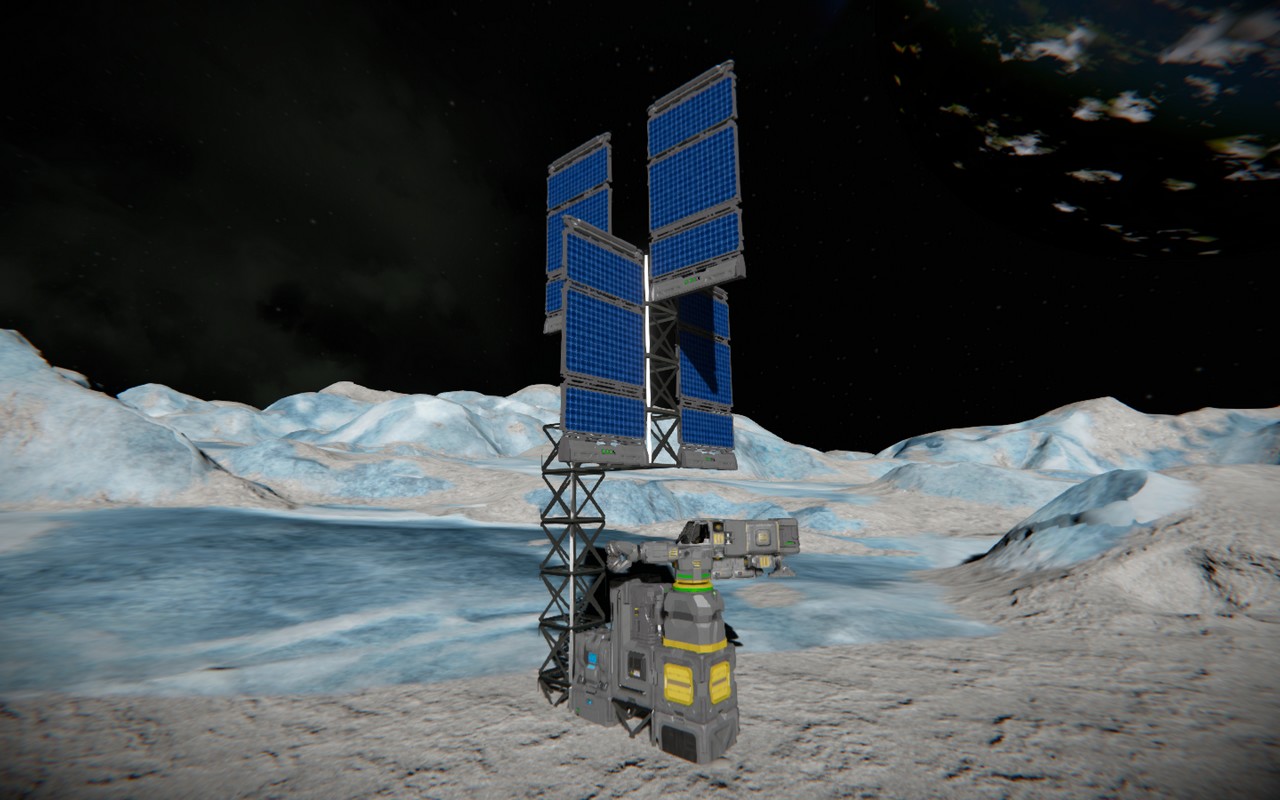
Survival on Pertam
Pertam is a planet with a gravitational force of 1.2g and a very small amount of ice, which lies quite deep in oases on which some grass and trees grow. Therefore, here you will have to look not for ice or snow, but for such places.
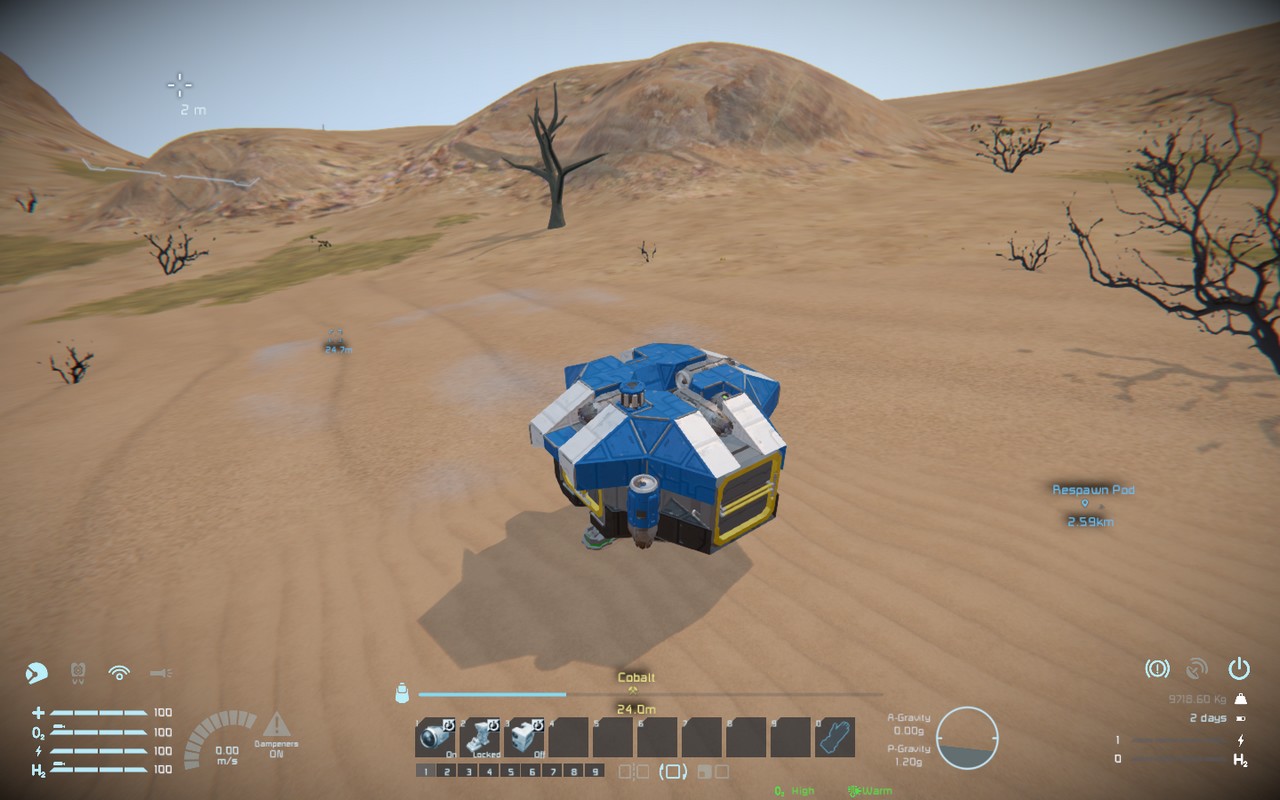
Survival is carried out according to the standard scenario, but it is better to immediately start deploying the base on the spot and install thrusters on all axes on the capsule. To do this, it is enough to build a basic assembler and a turbine, and after the capsule is ready, cut everything off and fly to choose a place for a regular base near a cobalt deposit, which can be quickly detected from the air by white spots on the surface.
Small universal ship
At the end of the survival process, you can modify the miner, turning it into a universal tool with which you can quickly fly long distances, automatically mine ore, as well as weld and saw various structures, and even resist vanilla pirate drones or stations.
To do this, you will need to increase its carrying capacity with another medium container, add large small grid conveyors to switch to welders and cutters, increase the number of thrusters and install 4 batteries so as not to lose autonomy. This is how the miner will look like in the civilian version:
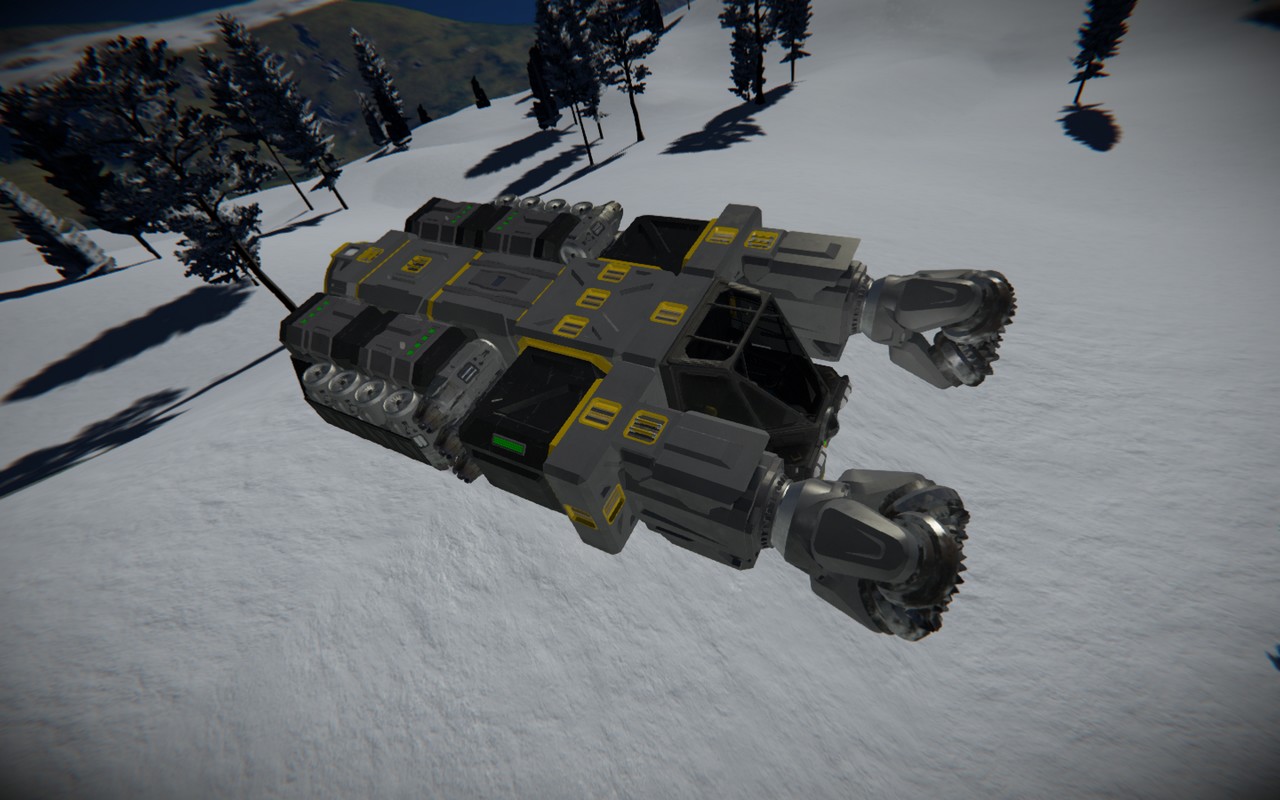
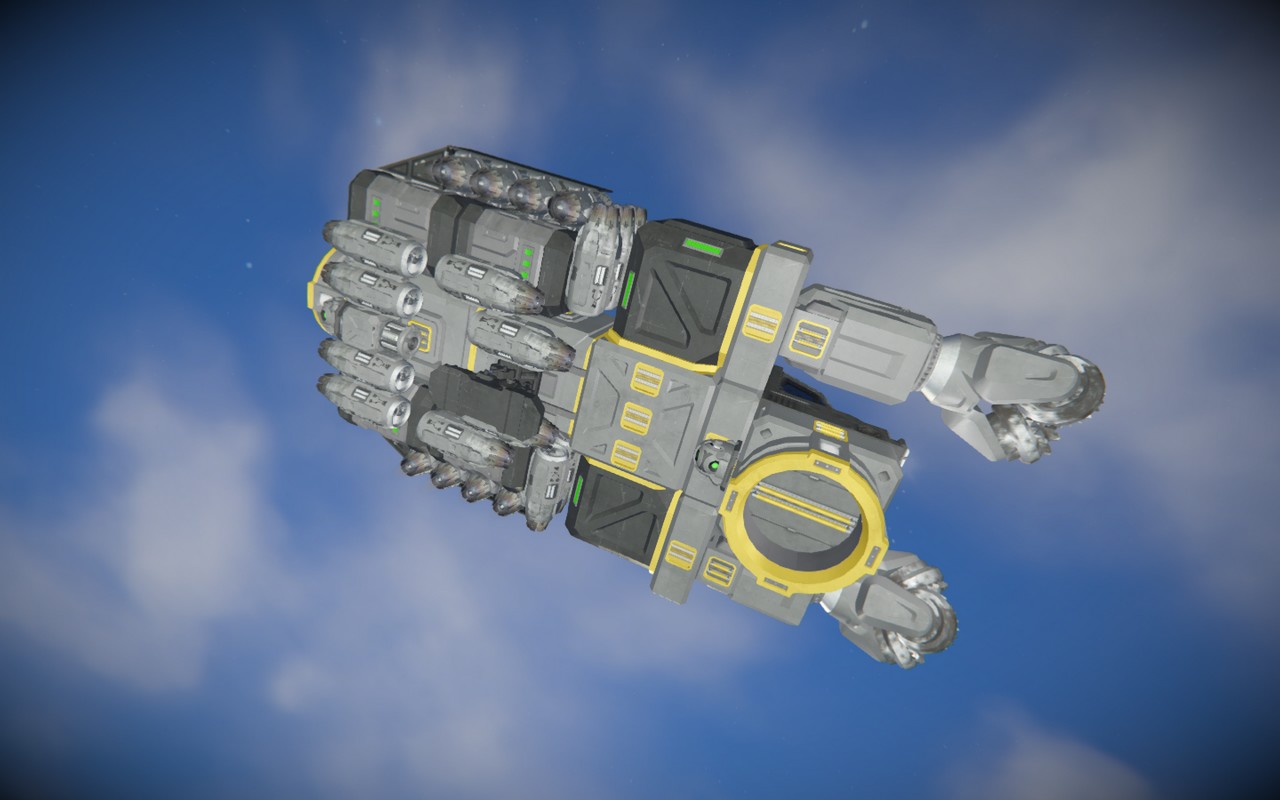
The military modification includes course and automatic armament, armoring of the bottom with half-blocks of light armor, a projector for restoring damage after a battle, an emergency reactor and a program block for the Grand Cruise gravity flight automation script.
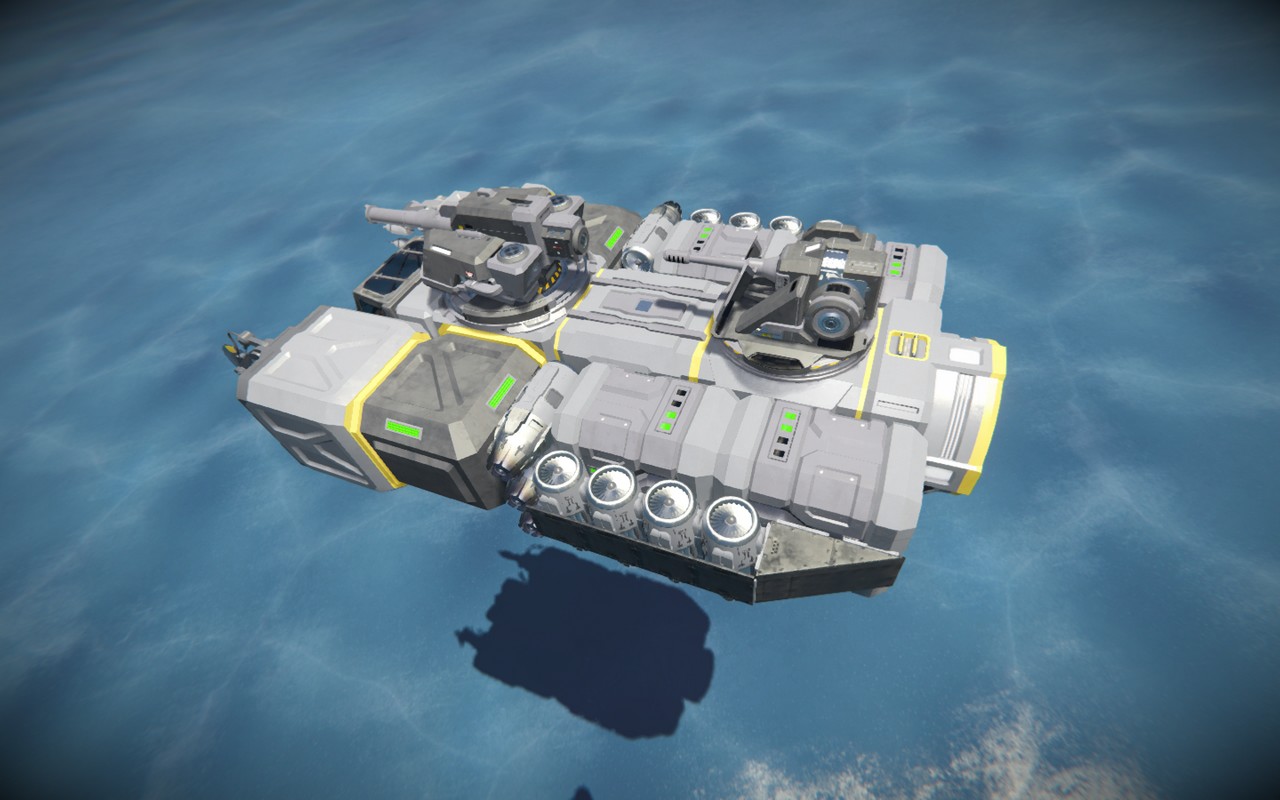
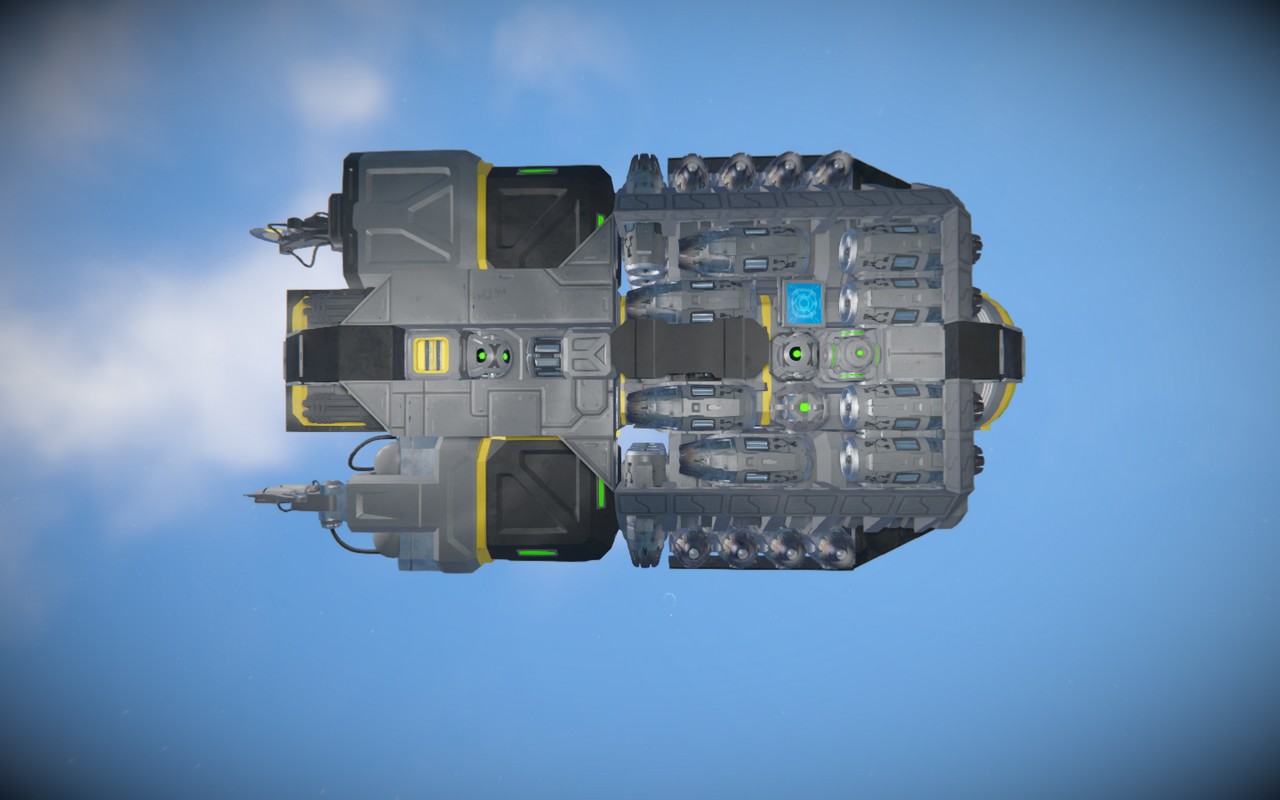
The only drawback of such a ship is the lack of an O2/H2 generator, so you will have to fly on a jetpack and breathe from cylinders that are loaded into the cockpit along with the character’s personal weapon. Sequential modification of the original respawn capsule allows you to save a permanent in-game marker, by which the ship can be seen on the screen from any distance, which makes it possible not to install radio signal sources in the form of a beacon or antenna on it.
In space, atmospheric thrusters change to ion thrusters now in all 6 directions. For the atmospheric version, downward-facing thrusters are not needed; there is gravity for this.
